
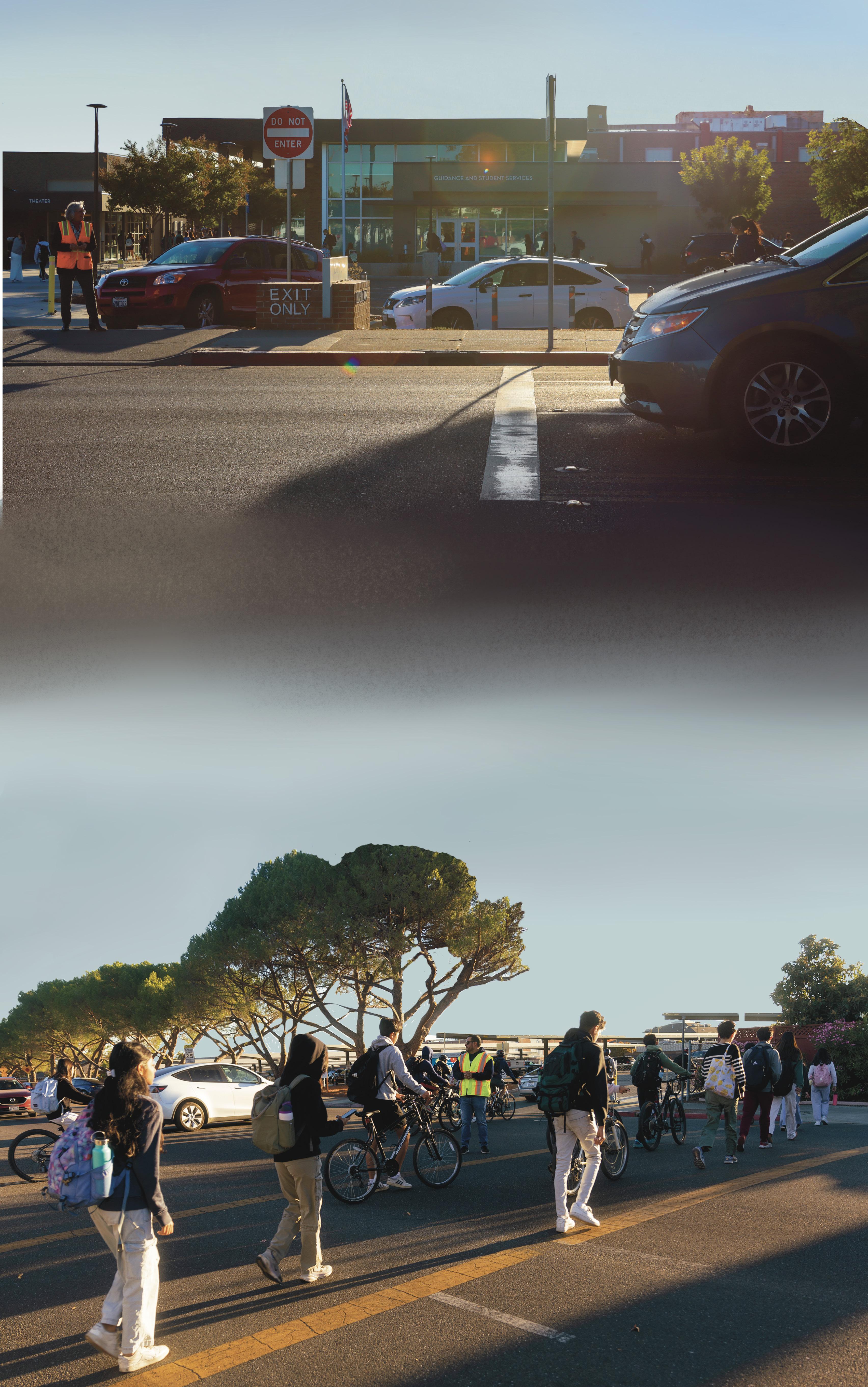



As each school day starts, chaos sweeps through the lanes of Johnson Avenue, the major road that acts as both an entrance and exit to Lynbrook’s campus. Cars wait impatiently to turn, students hurriedly cross the street and bikers swerve through intersections. As a result, busy areas such as the intersections and drop-off areas along Johnson Avenue have been known for collisions between pedestrians, bicyclists and cars, gaining the attention of students, staff members and worried parents alike. To best combat this, the Lynbrook community should increase awareness surrounding current safety issues and look into reinforcing safety efforts around campus.
Currently, Lynbrook’s administration has been trying to keep themselves involved in student safety — regularly sending staff to manage crosswalks and drop-off areas. Such efforts have not been in vain: traffc congestion has been signifcantly reduced, and overall effciency in drop-off areas has increased, but their efforts alone are not always fully suffcient. Although they help establish a higher safety standard around campus, jaywalking, distracted driving and other hazardous behaviors out of administrators’ control continue to cause stress and danger.
Story continued on page 5.




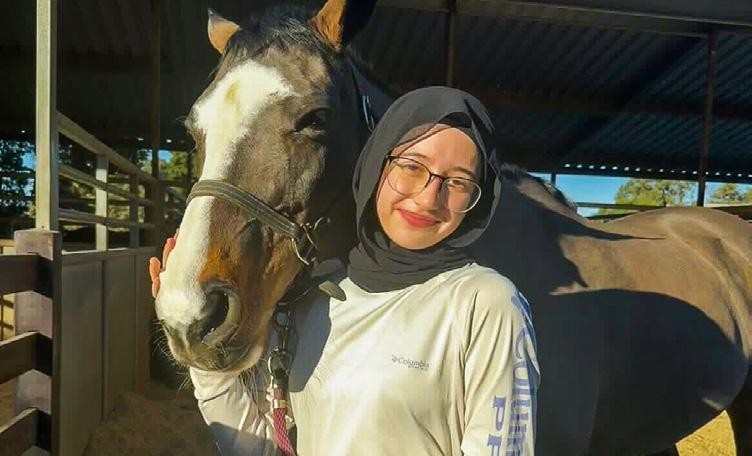

We hope you all had a spooky Halloween! As seniors move past early application deadlines and everyone heads into the fnal stretch of the semester, we hope that Issue 2 of the Epic will give you a chance to sit down, relax and catch up on what’s happening around campus.
Be sure to check out the Editors’ picks! Learn about the upcoming elections in News; uncover campus student safety in Opinion; explore a former Lynbrook teacher’s novel, “Louder Than the Lies,” in Features; delve into Curriculum Integrity’s goals in In-Depth and saddle up for equestrianism in Sports.
Did you know that we also have content exclusively online? Visit our website, lhsepic.com, for web-exclusive content; our YouTube channel, the Epic and our Instagram, @lhs.epic, for coverage on sports games and school events.
Stay spooky, Ashley Huang & Alyssa Wang Editors-in-Chief
BY LILLY WU

On Sept. 23, Lynbrook was announced as a National Blue Ribbon School for 2024. This year, the National Blue Ribbon School Award was granted to 356 schools that display excellence in academic performance and serve as positive examples for schools across the nation. Other local winners include Joaquin Miller Middle School and Leigh High School. This is the frst time that Lynbrook has won the award since 2008. Principal Maria Jackson, Assistant Principal David Erwin and FUHSD Superintendent Graham Clark will be fying to Washington, D.C. to attend the national awards ceremony from Nov. 7-8.

Residents of Florida were greatly impacted when Hurricane Milton hit on Oct. 7, resulting in fooding, wind damage and power outages. Starting less than two weeks after Hurricane Helene and dissipating on Oct. 12, this storm is the second most intense Atlantic hurricane to date after Hurricane Rita in 2005 and the strongest tropical cyclone in 2024 so far. Milton was categorized as a Category 5 major hurricane, with its highest winds reaching 180 miles per hour. There have been 24 confrmed deaths in the United States and three in Mexico, with over $30 billion in estimated damages from the storm.

Just before midnight on Oct. 17, a fre broke out in a house near the intersection of Johnson Avenue and Brookhaven Drive. The police and fre department arrived shortly after and were able to put out the fre completely by 4 a.m. While nobody was hurt, the garage and nearby shed were burnt. Fortunately, the frewall in the house prevented the entire house from catching on fre.
“It was really scary because it was just two or three houses away from my house on the other side of the street,” sophomore Ishanvi Hullur said. “It’s frightening to be in that situation when you know it could have been us.”

Cuba began to experience a nationwide power outage due to the failures of the Antonio Guiteras Power Plant on Oct. 18. More widely known as the 2024 Cuba blackout, this incident is the most severe energy failure the country has experienced since 1991. Although the plant was temporarily restored, it shut down again on Oct. 20, impacting approximately 11 million people. Due to the blackout, protests broke out shortly after, with many building makeshift barricades in the streets. While it was hoped that the power outage would end by Oct. 22, Hurricane Oscar slowed down the progress made to improve the situation.
BY GARY PAN
On Oct. 22, the San José City Council met to vote on the possible opening of a Costco near the Westgate Shopping Center in West San José. The meeting resulted in the approval of the Westgate Costco, and construction is expected to start soon. This decision was made amid heavy debate from residents over whether or not the store should be built. Some voiced concerns over increased sound and traffc for residents in the Westgate area, while others supported the business, believing that the increased foot traffc would boost other businesses in the mall.
Costco frst submitted its architectural plans for construction on Nov. 17, 2021, and has since submitted fve additional plans and revisions. However, it was not until Sept. 25 that the San José Planning Commission recommended that the San José City Council approve the retail giant’s plans after it certifed the environmental impact of the company.
Costco has allocated around $60 million to this new location. Plans right now include the demolition of three buildings in Westgate, totaling an area of 188,265 square feet. Stores such as Ethan Allen, Goodwill, Bikram Yoga San José and the now-closed Smart & Final are in the area to be demolished. They will be replaced with a 165,148-square-foot building to encompass the storefront, which will contain the main warehouse and an accompanying tire center and rooftop parking.
“I believe Costco will be a much better alternative to supermarkets,” senior Hao Gu said. “Costco’s items are always so cheap and I think Costco can make the general mall area much more developed.”
Along with the new store, Costco will hire approximately 300 employees, and sales are projected to bring around 2 million dollars of annual tax revenue. Traffc to the mall is also expected to increase heavily.

Residents have long been ambivalent about the project. Some residents welcome the new opening, seeing Costco as a way to revive the lessfrequented center after the closing of JCPenney and Orchard Supply Hardware. They also appreciate Costco’s accessibility compared to the current nearest location
in Sunnyvale, 5.9 miles away. Other community members worry about the project, citing a lack of traffc safety studies and the need for an urban village development instead of a big-box warehouse.
“I’ve been a Costco member for many decades,” said Marc Pawliger, cofounder of Save West Valley!, a local group against the installation of the Westgate Costco.

“We understand that the Costco will be a great way to increase the tax base and that San José is a very development-friendly city, so it’s hard for City Council members to be against the project. But Westgate is not the right area. The Costco will be way too oversized in an undersized neighborhood and safety concerns naturally arise.”
Westgate is extremely close to residential areas and local schools, like Prospect High School and Country Lane Elementary School, which have a history of traffc congestion and pedestrians.
Residents cited that the size of the Costco would inconvenience the residential area while also endangering pedestrians. Some Prospect and Country Lane community members also expressed concerns about what increased traffc would mean for local students.
“The Costco will be really good for getting groceries,” Prospect senior Roderick Ma said. “Costco has cheap prices and the food court could be a good way for students to eat. However, I do see how the traffc would get worse, and parents won’t have a good time picking up and dropping their kids off at school.”
On the other hand, Westgate businesses such as Bikram Yoga and Dave’s Hot Chicken argued that Costco would increase the fow of customers to other businesses in the area, revitalizing the monthly decline in visitors.
At the Oct. 22 meeting, a Costco representative, residents, local business owners and Save West Valley! members voiced their opinions on the proposed Costco. The meeting allowed residents to voice their criticism and Costco to adjust plans accordingly. Adjustments include reducing the size of the warehouse near Graves Avenue and including rooftop parking to alleviate traffc concerns. After several nuanced discussions, the council eventually voted 8-0 in favor of the opening of Costco.
The construction of Costco will take two years and must adhere to the City Council’s memorandum addressing residential concerns. Costco must also provide a daily volume comparison of the pre- and post-opening traffc within 12 months of opening to see how the general area’s traffc can be improved. Other requirements include a physical gate on the Graves driveway to reduce traffc fow between 9 p.m. and 6 a.m. every day, and a 6-foot wall in place of the current 4-foot wall along Graves Avenue to reduce disturbance to the nearby community.
BY TAEK KIM
In the leadup to the frst-ever FUHSD by-area trustee elections, four candidates total are contending for the positions of the next Area 2 and 5 trustees: Pat Carpio-Aguilar and Frances Renteria for Area 2, and Danny Choi and Aegean Lee for Area 5.
The decision for FUHSD to transition from at-large to by-area trustee elections was made fnal by a resolution passed by the current Board of Trustees on March 7, 2023. This means that voters will elect not multiple trustees per election cycle for the entire district, but one trustee to represent the area in which they live. The decision split the district into fve areas encompassing the cities of Cupertino, West San José and Sunnyvale.
This system aims to create more board representation across the district, as previous trustees were disproportionately from Cupertino and West San José. At the request of the Board, the Community Trustee Area Districting Committee was formed in October 2023 to facilitate a smooth transition.
“This is the frst time that northern Sunnyvale, the two northernmost zip codes, will have any representation historically on the board,” Carpio-Aguilar said.
The transition process was tumultuous at times, with many community members requesting that the district delay the process. CTAD moved forward with the process while taking community feedback into account, producing a fnal map that the board unanimously approved on April 24, and that was followed by approval by the County Committee on School District Organization.
“We’ve generally had very good trustee boards over our district’s 100-year history. Although we are moving to a new way of electing trustees, we are hopeful and confdent that we’ll continue to have great boards that will lead the whole district.
“
Along with approving policies and budgets, FUHSD trustees lay out the
visions and directives for how they would like to see the district handle challenges and goals, such as school construction.
“At each school, we have at least one project under construction and additionally one under design,” Clark said. “The trustees will take the time to approve those contracts and designs, and so there’s extra work associated with all that.”
For the upcoming elections, trustees Rod Sinks and Jeff Moe will reach the end of their term lengths, paving the way for Areas 2 and 5 to elect their new trustees. Area 1, 3 and 4 elections will be held in 2026, when the terms of trustees Rosa Kim, Naomi Nakano-Matsumoto and Stanley Kou end.
Area 5 candidate and Lynbrook alumus Choi started his public service career as a teacher and currently teaches English at Liberty Alternative School in San José. He was initially hesitant to run for the trustee position, but decided to seize the opportunity after remembering the advice he always gives to his students about growth mindsets.
“I’m naturally an introvert, so learning to be comfortable in speaking with people in public settings was comparable to your frst time going to a school dance,” Choi said. “You’re just standing in the middle of the foor, not knowing what you’re supposed to do, and all these insecurities and awkwardnesses get to you. But now I feel competent and prepared to handle the socializing elements of the campaign trail.”
Choi’s priorities include tackling declining FUHSD enrollment and improving student mental health and safety. He also plans on ensuring highquality programs and options for students by fostering a multitude of world language course offerings.
“I’ve worked with students from all sorts of different socioeconomic and ethnic backgrounds, so I’ve been exposed to a large array of humanity in a way that is almost impossible to replicate if you’re not a fellow teacher,” Choi said. “Teachers, admin, parents and the rest of the community play a role in leading our students, but ultimately, when you’re making decisions at the board level, you should be thinking about how district policies and changes actually impact its young people.”
As a parent of a Lynbrook graduate, Area 5 candidate Lee has been involved in the community such as through her role as a Boy Scout Leader and a Program Director of the IDEA Educational Foundation, a nonproft dedicated to


serving the community through the creation and development of educational programs. Her campaign centers on providing high-quality education, ensuring transparency and accountability regarding district fnances and engaging community members, especially parents, in public forums.
A former frefghter and Deputy State Fire Marshal, Area 2 trustee candidate Frances Renteria aims to increase parental transparency, academic excellence and parent-teacher partnership. Furthermore, she plans to ensure student safety and encourage diversity of thoughts, background and culture in schools.
A teacher at Columbia High School in Sunnyvale, Area 2 trustee candidate Carpio-Aguilar seeks to utilize her experience as an educator to deliver proper high school education and experiences for FUHSD students.
“Having a teacher as a board member would be great since their background would be applicable to the decisions that will take place in the boardroom,” Carpio-Aguilar said. “High school is a big deal, and I bring the credentials, the experience and the deep knowledge of what it’s like to live and breathe education.”
As a trustee, Carpio-Aguilar plans to create equitable and effcient transportation to enable students to travel to and from school on time. Along with supporting representation, identity and inclusion, she also plans to increase student representation in board meetings and decisions.
“I want student voices in the boardroom and for them to feel comfortable coming to the boardroom,” Carpio-Aguilar said.
With Election Day on Nov. 5, this will be a historic moment for FUHSD as this is their frst by-trustee area election, giving constituents the ability to choose from a pool of dedicated candidates to serve in their district.
“We have great candidates, and they’ve been running a good election,” Clark said. “No matter how the elections turnout, we will have some great new candidates on the board.”

Diwali Decorations on Campus, Nov. 4
View a decorated campus and dress up in traditional Indian clothing.
Winter Sports Begin, Nov. 4
Veterans Day, Nov. 11
On this day, all schools nationwide will close to honor the services of military veterans.
IDC Fantastics Rally, Nov. 15
Show your spirit with all FUHSD schools in a district-wide rally at Fremont High School. Various activities and games will determine the winning school.
Holiday Craft Faire, Nov. 23
Join the Lynbrook Instrumental Music Boosters for their annual craft faire featuring local vendors, a bake sale raffes and more. Proceeds will go toward supporting the music department.
Thanksgiving Break, Nov. 27-29
Photo and reporting by Irene Hwang.

FUHSD Trustee Areas
KEY: 2024
Areas 2 and 5
2026
Areas 1, 3 and 4
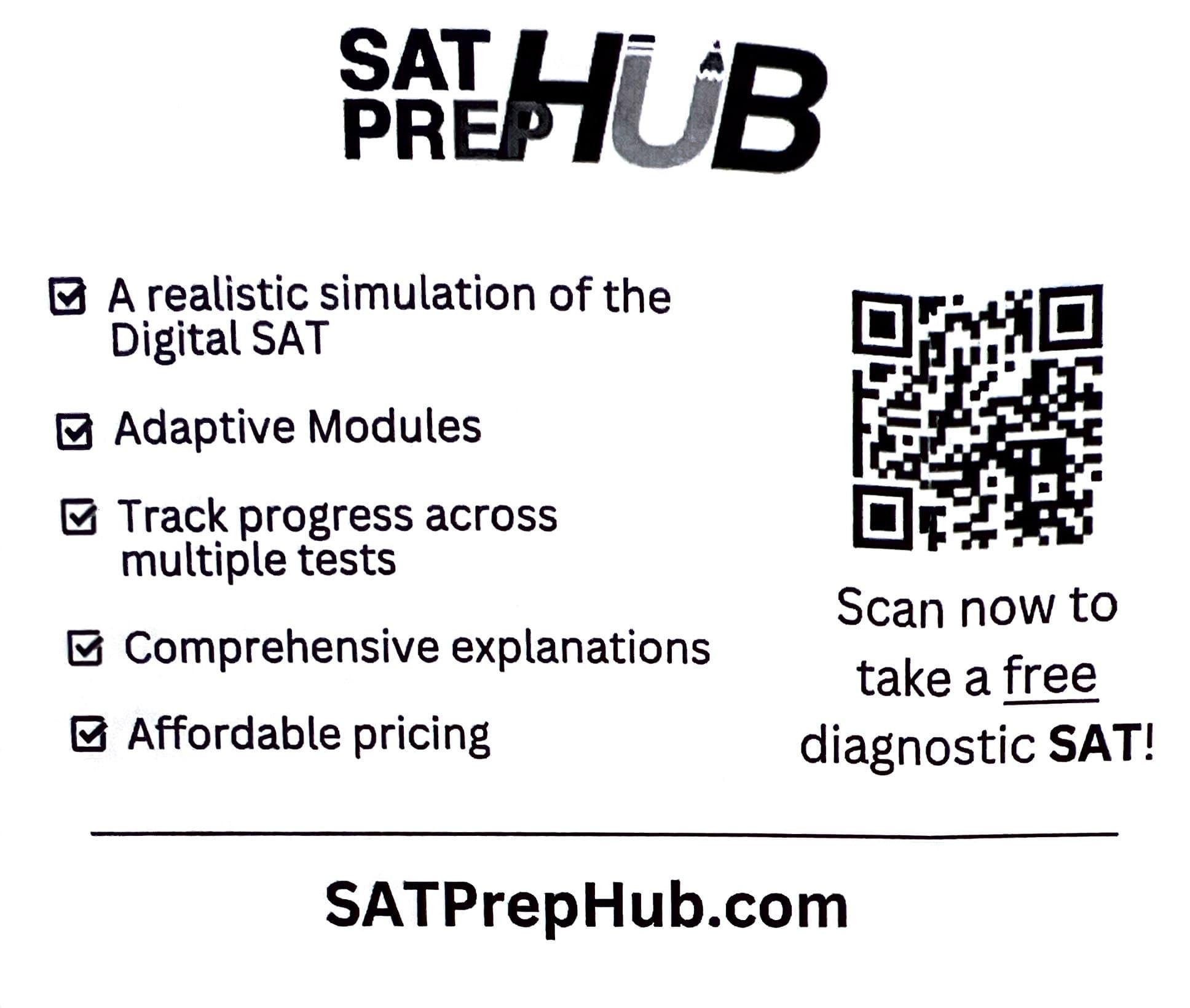
BY ROBERT YU
On Oct. 10, the Fremont Union High Schools Foundation hosted and sponsored a webinar, inviting speakers Ned Johnson and Bill Stixrud to cover academic tension and how parents can help alleviate stress in a balanced manner. This was organized in collaboration with Silicon Valley-based organization the Parent Venture. There were a total of over 500 registrations from both FUHSD and Parent Venture.
The FUHSF has been hosting student wellness webinars since 2019. Previously, these webinars have been hosted live, but due to COVID-19, they have since shifted online. As an organization independent of FUHSD, the Foundation has allocated a budget of $6,000 to sponsor webinars every year. A future wellness webinar can be expected this year.
“The Parent Venture has been a wonderful partner in helping us produce webinars,” FUHSF board member Rita Allen said. “This particular subject was selected because one of the foundation’s goals is to support student wellness.”
Johnson and Stixrud have previously engaged in many fronts on the topic of adolescent stress and parenting. Johnson is the founder of tutoring organization PrepMatters. Stixrud is the founder of the neuropsychologist collective Stixrud Group. Together, they have co-authored two popular books, “What Do You Say?” and “The Self-Driven Child,” on parent-student connections.
“Because Lynbrook is an academically competitive place, lots of kids are under too much pressure,” Johnson
said. “We are on a mission to help foster a healthy sense of control for everybody, especially students.”
The webinar, “A Sense Of Control,” offered parents insights on lowering student stress and improving academic success in a balanced manner. Instead of harsher traditional remedies like cellphone bans and lectures, Johnson and Stixrud introduced alternative methods for parents to encourage healthy academic and emotional growth.
The webinar began with a presentation delving into topics such as parent openness, communication strategies and maintaining reasonable expectations for their children.
According to Johnson and Stixrud, one of the key parts of maintaining student motivation in a balanced manner is perfecting the conversations between child and parent. They emphasized that prioritizing empathy in conversations leads to a positive feedback loop that reinforces motivation and selfsuffciency.
is a naturally ingrained stigma about discussing mental health in relation to academics. Frequent checkups can help alleviate this stigma.”

“It’s your call”
To combat this, Johnson and Stixrud frst introduced the approach of parents providing open-ended suggestions rather than enforcing concrete rules. They then highlighted the importance of parents to validate their children’s struggles.
Parents should act as consultants and respond with “it’s your call” when a student needs help making decisions.
Parents should validate their children’s struggles, as their connection is a strong protective factor against
Parents should maintain a feasible model reality for their children to attain by focusing on positive emotions.
“Having more open conversation between students and parents can allow students to move forward,” senior Saarang Mallipeddi said. “In some communities, there
“Generally speaking, I think that family relationships are the largest factor in managing stress,” school counselor Shana Howden said. “Students are only at school for eight hours a day — a much shorter time than they spend with family.” Johnson and Stixrud then mentioned the importance of targeting this model reality, encouraging students and parents to set up realistic goals together.
“Every parent wants their children to be successful,” Johnson said. “Refecting on this webinar, I hope that we made parents and students feel safer by helping parents exude less control and students fnd their motivation.”
BY DAVID ZHU
Numerous candidates are campaigning for a seat in the San José City Council, California State Legislature, United States Congress and White House in November. For many candidates, months of mobilizing supporters, canvassing and mass outreach have built up to these pivotal moments, which will determine political leadership at the local and national levels for the next few years. With Election Day quickly approaching on Nov. 5, many voters prepare to select the candidates they feel are the most qualifed.
In District 2, which encompasses South San José, educator Pamela Campos, who prioritizes youth homelessness and the high cost of living, is running against retired sheriff’s sergeant Joe Lopez, who hones in on community safety and homelessness.
Incumbent Domingo Candelas, focusing on homelessness and the high costs of living, faces Sergeant Tam Truong in the race for District 8 in East San José. Truong has honed in on expanding job access, alleviating homelessness and expanding housing access.
In District 10, which includes part of South San José, incumbent Arjun Batra is running against senior councilmember George Casey. Batra aims to address homelessness, increase the number of frst responders and improve traffc safety near schools. Casey has called for lower taxes, the construction of more housing units near jobs and a stronger police force.
Of the two U.S. senators currently representing California, one will be replaced following the November general election. Laphonza Butler was appointed senator by Governor Gavin Newsom after the death of former senator Dianne Feinstein in early 2023. However, in October 2023, Butler announced that she would not be running for reelection. Therefore, two new candidates are currently competing for her spot in the general election.
Former professional major league baseball player and Republican Steve Garvey is facing off against U.S. representative and Democrat Adam Schiff.

Garvey believes in increasing border patrol funding in order to enforce stricter control over the southern national border. In response to the rising costs of living, Garvey proposes curbing federal spending to limit infation and expanding the supply of housing for low-income families by supporting the federal low-income housing tax credit.
Schiff promises to tackle the issues of housing affordability and homelessness by dramatically expanding the supply of affordable housing through increased federal investments and tax credits. He also aims to address economic scarcity in order to combat infation by prioritizing the production of renewable energy and increasing the number of healthcare professionals.

In Assembly District 26, which encompasses parts of Cupertino, Sunnyvale, Santa Clara and West San José, Patrick Ahrens, current District 26 Assemblymember Evan Low’s district director, is facing off against Santa Clara County Offce of Education board member Tara Sreekrishnan.
Ahrens made affordable housing, healthcare, public safety and education his biggest campaign priorities.
Sreekrishnan shares many of the same priorities as Ahrens, but with a particular emphasis on education, healthcare, insurance and housing. She centers her campaign around ensuring affordability in each of these areas.
Incumbent Democrat Dave Cortese is running against Republican Robert Howell in the race for State Senate District 15, which includes parts of Cupertino, Los Gatos, Campbell, Monte Senero and San José.
Cortese has continued to prioritize the issues he tackled during his time in offce: housing affordability, homelessness, public safety, climate, transit infrastructure and education. As a longtime Chief Executive Offcer and Chief Design Engineer of Extran, a cybersecurity equipment manufacturer in Silicon Valley, Howell is very pro-business, having previously described himself as a “plain spoken businessman” when running to be Insurance Commissioner.
On the U.S., Election Day on Nov. 5 will determine who will sit at the Oval Offce desk for the next four years.
Former president and Republican candidate Donald Trump is running against vice president and Democratic candidate Kamala Harris. Initially, incumbent president Joe Biden was selected as the Democratic candidate for the presidential election, but after dropping out of the race in late July 2024, Harris was selected as the new democratic nominee.
Both parties have poured tremendous resources into campaigning and appealing to voters across the country. In the fnal stages of campaigning, Harris and Trump are focusing on reaching voters in the swing states of the election — states that could reasonably be won by either candidate. Both candidates have campaign events scheduled in the swing states of North Carolina and Georgia, and Harris also plans to campaign in Pennsylvania as of Oct. 30.
Story continued from front page.
“It’s not always safe — people are always in a hurry, and as a result, they drive recklessly,” said sophomore Rayna Kumar, whose parents’ car was totaled due to a swerving driver near Johnson Avenue. “Since it’s early in the morning, not everybody is fully awake, and you can tell based on how they drive.”
Unfortunately, it is not just morning grogginess that endangers these roads. According to a survey sent out to Lynbrook students regarding traffc safety, 57.6% of 158 respondents indicated that reckless or distracted driving is one of the main catalysts behind safety problems. 50% indicated miscommunications on the roads, while 49.4% cited inattentive pedestrian crossing. Additionally, 45.6% of respondents indicated that they arrive at school less than fve minutes before school, another possible explanation for the increasing chaos approaching school start time.
conversations, cell phones and being impatient that cause problems.”
Other more nuanced issues, such as the lack of essential protective gear, also contribute to safety concerns on these roads. For bikers, not wearing a helmet presents signifcant risks.
58%
of respondents agreed that reckless or distracted driving was the main cause of accidents around campus
“As a biker, I know that wearing a helmet is for protection, even though it’s uncomfortable sometimes,” junior Yule Kim said. “I think we all know the dangers of not wearing a helmet, but it also just doesn’t occur to me that something might happen.”
According to survey of 158 responses.
In these instances, the temptation of convenience can compromise safety, highlighting the need for students to recognize the lasting consequences that can arise from overlooking safety measures.
“We’re humans — accidents will happen,” said Tim Wehner, Lynbrook crosswalk guard and paraeducator. “But if people do know the rules of the road and commit to safety and courtesy, I don’t think we have to restructure. It’s all workable — it’s just distractions from
“Awareness is key,” student conduct specialist Thomas Lopez said. “Don’t have headphones all the way in and don’t be glued to the phone screen — those are really big factors that cause accidents. It would be nice for drivers to be more patient so the students can get to class safely. Bikers and pedestrians should not be afraid to cross the road.”
While some safety measures such as having staff direct traffc are implemented at the school level, other initiatives, such as hiring new staff to regulate
Staf Editorial // The voice of the Epic
traffc, remain outside of Lynbrook administration’s control. Since their presence would only be necessary during specifc times of the day, it makes hiring diffcult. Current staff monitor traffc as volunteers on top of their already existing responsibilities. However, advisories or school-wide lessons on traffc safety may be implementable by integrating them with the curriculum because the school can host Lynbrook-specifc advisories one to two times a year. This would greatly beneft the current traffc situation due to advisories being one of the most unifed ways of informing our student body of any changes.
Given these limitations, the Lynbrook community needs to ensure that potential new initiatives will effectively reach our community. For administration, this could take the form of clarifying safety practices such as crosswalk etiquette and helmet-wearing through emails or even the occasional Lynbrook public webinar. For students, this could take the form of broadcasting reminders through the ASB morning announcements or even starting new initiatives dedicated to traffc safety with the Legislative Council.
Students should also be expected to have a comprehensive understanding of traffc laws and safety etiquette. Parents dropping their students off in a designated legal area would greatly enhance safety efforts. If the district or school decides to implement a parent volunteer program, it would be a valuable way for parents to contribute, such as serving as crosswalk
guards. These efforts can help raise awareness of current issues and remind both students and community members to adhere to traffc safety and enhance safety standards.
“You only cross the street for 15 to 30 seconds,” Wehner said. “But that might be the most important time because close calls and accidents can happen in those split-second moments. Students aren’t being aware of that coming into the intersections.”
Traffc safety and regulation ultimately impact students, parents and staff alike. It is the joint responsibility of the Lynbrook community to maintain a safe environment on roads near Lynbrook.
Students generally are pretty diligent with traffc rules; they’re patient and students pay attention. But all it takes is one student, one accident, so we have to plan and try to reduce it as much as we can until the possibility of sudents getting hurt is close to zero.
Maria Jackson Principal
the Epic staff voted 34-0 in favor of this stance with 5 abstaining.


editors-in-chief — ashley huang, alyssa wang
managing editor
— lilly wu
copy editors — qianzi loo, emily pedroza
design editors
— vidushi upadhyay, eileen zhu
news editor — olivia yuan
opinion editors — crystal zhu, david zhu
in-depth editor
sports editor
web editors
stafers
akash anand
charlotte bolay
anushka deshmukh
angelina feng
rohan kakhandiki
brian lee
ethan wong
alexandra wu
adviser
— josh miller
business/pr manager features editor — claire guo
— alex cotterel
— amanda jin
— meadow shen, yvonne wu
— taek kim
social media manager — inaaya yousuf
rebecca cai
anna cen
maddy chang
isabella chiu
erin fitzpatrick
kieran hau
irene hwang
stuti jain
valued contributors: Guojing Liu
gary pan
saavan saraf
jenny suh
olivia tu
cecilia wu
robert yu
BY AKASH ANAND
With the presidential election taking place on Nov. 5 between Vice President Kamala Harris and former President Donald Trump, many students continue to discuss political views and their diverse perspectives on the candidates and the election.
“ ere’s a lot of economic, infrastructure and funding issues going on right now. In addition, a lot of discussions around topics like abortion and state rights are present, so those need to be addressed. I think both parties have their ways of improving the nation, but of the two candidates, it would be good for Kamala Harris to be elected because of how she views speci c policies and how she relates to the general American public instead of just certain audiences.”

“I have been following the news a little bit, and I’m seeing issues on headlines such as the state of the economy, housing prices in America and the civil and natural rights that people should have. While both candidates have many unique thoughts on such issues, I would say that I’m mostly neutral since I haven’t explored enough on the issues and both candidates don’t provide any concrete solutions with their policies, so I have no true common ground with them.”

“I’ve been tracking the election, but I wouldn’t say that I avidly follow the mass media of the election. I’m very scally conservative, so a lot of the issues I notice arise from the state of our economy and market. ere are a lot of problems with overspending, and I think that the Democrats have de nitely demonstrated that in this last term. I think Trump is a little more transparent with some of his policies, and that is why I think he’s more bene cial.”

“I’ve heard people talk about their concerns with the economy and their rights. I think Kamala Harris would be better because she would strike a balance between helping the economy and protecting civil rights. Some of her actions that I agree with are removing taxes on tips and giving tax breaks. I would say the better political party depends on the representative candidate, and seeing how California is being run right now, I’d say the Democrats are doing a decent job.”

BY YVONNE WU

In September, California took steps to ban legacy and donor admissions in private non-proft institutions with Assembly Bill 1780 — which will be effective Sept. 1, 2025. But due to widespread inequality, this practice is not widely adopted enough and should be put in place for all institutions across the country.
Historically, legacy admissions — admissions that give priority to relatives of alumni — were frst employed at Ivy League institutions with the intention to keep Jewish immigrants out of elite universities. Nowadays, this pervasive phenomenon of social inequality has been deeply normalized. Elite level education institutions and the majority of legacyadmitted students don’t protest against it, and even though a community protesting the system has sprung up, legacy admissions are still heavily enforced.
“Legacy admissions are unfair, and I am against it,” senior Aditi Adapala said. “It doesn’t make any sense to give students merit for something their parents did.”
These admissions put low-income individuals without legacy status at a major disadvantage for possible future economic success because a seat for a legacy student means one less seat for them. As stated in a 2017 research paper by Chetty et.al, “at any given college, students from low- and high-income families have very similar earnings outcomes.”

This means that for many low-income students, a seat at that prestigious institution can signifcantly determine their future economic trajectory.
According to an article from The Brooklyn Rail which states, “almost no poor people have
alumni experience at elite universities,” majority of legacy admits come from high-income households. The point is further detailed in an Invincible Voices article which states that given similar SAT scores, students from the wealthiest 1% of households are twice as likely to enroll in prestigious private colleges compared to students with middle-class backgrounds. This system effectively creates a cycle that continually uplifts the wealthy and tramples the poor.
Not only do legacy admissions disproportionately affect lowincome students, but also enables corrupt college offcials to further any personalized agendas. They fll their pockets with large donations, making it more diffcult for less prestigious colleges to receive similar funds. This effectively locks its elite status in place and contributes to the inequitable pattern of rich institutions getting richer and poorer institutions staying poor.

our country by taking from the poor and giving to the rich.
Inevitably, supporters of legacy admissions counter that in terms of meritocracy, affrmative action — admission that takes in consideration one’s racial identity — and legacy admissions are both unethical. Even though affrmative action has been removed from all admissions systems, it is an argument critics use to draw attention away from the fundamentally troubling ethics of legacy admissions.
9%
of the income for private non-proft institutions and 2% of the income for private proft institutions come from government grants.
Corruption is jarringly refected in the 2019 Varsity Blues college admission scandal where numerous wealthy parents were discovered to have bribed offcials to silence reports of cheating during standardized tests and college coaches to offcially recruit their underqualifed children as athletes.
According to National Institution for Education Statistics.
The only faw in this logic is that legacy admits and affrmative action admits often come from exceedingly opposite sides of the socioeconomic spectrum. In other words, affrmative action and legacy admission are by no means comparable in the debate of fairness. A large majority of affrmative action students are racial minorities that come from low-income backgrounds. They are often under-resourced, lacking the tools they need to build a solid application, therefore implementing affrmative action in the admission system can be an ethically sound decision.
In contrast, many legacy students are provided with an extensive arsenal of resources, tutoring and the opportunity to engage in prestigious levels of education from a young age, giving them an advantage when applications roll around.
The admission system that these institutions rally behind are funded not only by large donations but also by federal money.
According to National Institution For Education Statistics, government grants make up 9% of the income for private nonproft institutions, such as Massachusetts Institute of Technology and Harvard, and 2% of the income for private proft institutions, including the University of Southern California and the University of San Francisco. Governments use taxpayer money to create grants which are then used to support institutions, some of which only provide favored admissions prospects to legacy and high-income households. It perpetuates the issue of economic disparity within

“On the East Coast, there are many private schools that seem to have a more direct admission path to these top universities,” school counselor Malissa Goldstein said. “They have access to programs and connections that a lot of good, hard-working middle-class students don’t have.”
There is also a perception that these students would have been admitted to the university regardless of their legacy status because their achievements and merit alone often surpass that of other students. However, many legacy students are admitted to universities despite not meeting minimum admissions requirements.
The effects of AB 1780 on the admissions system have yet to be seen within private California universities. However, if it is successful in mitigating instances of unjust legacy admissions and increasing equality for lower- or middle-income families, the rest of the states should follow suit and enforce it as well.
“I think the only way to fx unfairness in admissions is to completely abolish legacy admissions as a practice,” Adapala said.
BY MADDY CHANG AND KIERAN HAU
In a world where the constant buzz and glow of notifcations have become the background noise of daily life, the idea of unplugging feels like a breath of fresh air. But for many, completely removing themselves from the digital world is not just diffcult — it’s impossible. As digital detoxes gain mainstream popularity, a hard truth must be acknowledged: the ability to disconnect is often an infeasible solution for the majority of the student population.
Despite this, it is crucial to acknowledge that the overuse of digital devices is a prevalent issue in today’s society, especially among young teens. Growing up inseparable from phones has caused much of the younger generation to feel the effects of digital addiction more heavily.
“There is an almost biological-like need to continue engaging with social media,” school psychologist Brittany Stevens said. “But digital devices are not necessarily fulflling or sustaining in the way other activities can be.”

Spending extensive time online can cause problems like anxiety, sleep deprivation and low self-esteem, raising concern about how students can be prevented from overusing this privilege.
According to a 2023 poll from the Gallup Familial and Adolescent Health Survey, American teenagers spend an average of 4.8 hours per day on social media.
“When you’re on social media, you’re constantly comparing yourself to the people and infuencers you see,” English teacher Joanna Chan said. “It’s a lot of content, so I think there’s a beneft to having a moment for quiet introspection.”
Digital detoxes — periods of time in which an individual completely removes themselves from their devices — have been a popular proposal to improve social media habits, with many believing that taking a step away from devices can solve addiction. Partial digital detoxes involve placing limits on time spent online, such as screen time limits, but are not an absolute separation.
Students, in particular, face growing pressure to unplug. Some parents send their children to digital detox camps, where devices are banned, costing up to $7000. Even without parental intervention, students may voluntarily engage in digital detoxes, encouraged by social media’s negative effects on their own mental health.
“It’s an addiction,” said senior Sanya Badhe, who participated in a 2-month social media detox in February. “You don’t realize how bad it is until you try to quit. At frst, I didn’t even notice my fngers would just keep going to YouTube. It was muscle memory.”
Although many have pushed for the adoption of digital detoxes in daily life, it
is essential to recognize that technology is far too integrated in modern society to disconnect entirely.
“Digital detoxes are tough, and the only way it will really have an effect on a large scale is if it was universally applied,” Stevens said. “It’s socially stunting to be the only kid who can’t use their phone or social media.”
While detoxes are praised for improving mental health by reducing phone use, they aren’t always a straightforward solution. In a study done by Oxford University, results show no evidence that digital detoxes have a positive effect on individuals at all. Participants reported “similar well-being” on both days with and without social media; instead of increasing face-to-face interactions, the study found that social interactions actually decreased during the detox period. Rather than equating the entire issue to technology, individuals should shift their focus to moderating screen time and setting clear boundaries with their devices.
“It’s the main way people connect, especially with strangers,” Badhe said. “If you go out, nobody asks for your phone number. They say, ‘Hey, can I get your Instagram?’ It’s hard to completely just remove that portion from your life.”
This fnding highlights a signifcant disparity in the conversation around digital detoxes: the assumption that disengaging from technology leads to improved well-being and social interaction. In reality, the relationship between an individual and their device is much more nuanced.
Students are expected to be active on their devices at all times, whether for digital assignments, important announcements or checking emails from their teachers about changing deadlines. In many cases, such as with dual enrollment, teachers and students communicate exclusively online, making constant connectivity a requirement for academic success.

media an unspoken requirement.
“I feel that it’s naive to say that you should be able to function without a phone,” Stevens said. “You literally have a computer in your pocket. We’re lucky to have that much information and content.”
Additionally, the ability to disconnect is also closely tied to socioeconomic factors, according to a study done by the Pew Research Center. Higher-income individuals often have the privilege of stepping away from devices without risking work opportunities. Yet, for lower-income individuals, such as students with part-time jobs where being online can mean missed shifts, being connected is a necessity. Digital devices serve as a lifeline, whether for job searching or access to essential government services like healthcare and banks.
“It’s defnitely easier to run company logistics with digital devices,” said sophomore Hannah Huang, a digital detox participant and part-time worker at a café.

“With group projects, social media allows you to communicate while avoiding sharing too much personal information like your phone number,” Chan said.
Moreover, students involved in leadership roles or extracurricular activities often rely on platforms like Messenger or Discord to manage groups for important updates. For club offcers and students who run business accounts, staying engaged with members and customers is a key part in building community and being a leader, making social
“If we were still in the age where you had to walk into a place with a resume, I would not have been able to get a job.”
As society continues to navigate the complexities of the digital age and technology advances, conversations surrounding them must also evolve. In place of mindless scrolling on platforms like TikTok and Instagram, students should create positive environments through interactions like commenting supportive messages on content. Intentional use allows devices to become a tool for support and community as opposed to getting lost in social media feeds.
“People have to regulate themselves and have self-discipline,” Chan said. “There are times where you need to be on social media, but there’s also times where it’s okay to step away.”
Rather than a complete disconnect from technology, students should take the responsibility of balancing academics and the need for social media in their daily lives. Using features like “Do Not Disturb” or various apps designed to increase productivity can help students designate times for their school work without falling into hours of doom-scrolling.


BY REBECCA
Warm water poured over my head in the sink of a small motel in Vermillion, South Dakota. My mom rinsed suds from the smooth sleeves of hair streaking across my forehead. She sang lullabies to me while I drifted off to sleep in the steaming bath.
In the deep freeze of Midwestern December, I christened Christmas with my delightful entrance into the world. My mom and I recovered in a small motel for 30 days before we traveled home to Hangzhou, China. Even though I’ve lived in the United States for 10 years now, I still partly consider Hangzhou my home. It was where I learned to write Chinese calligraphy, shoot a water gun at my brother and enjoy hour-long dinners with my family. It’s where I remember when I see a movie with an Asian family, like “How to Make Millions before Grandma Dies” or “Dìdi.” The movies look exactly like my childhood, when I spent every day with my relatives, spoiled by snacks and toys. It is why I cry when I see green parks swimming with toddlers walking hand-in-hand with their grandparents. Hangzhou, China, was the warm soil that fed and raised my little body.
Despite my roots there, China was also the frst place that rejected me. My older brother, born seven years prior, fulflled the legal limit of children enforced by the Chinese government. The One-Child Policy would not have allowed my birth unless my family paid the hefty fne or lost their jobs. The One-Child Policy nearly cost my life, but it cost my mom everything. After quitting her dream job as an architect, my mom packed her bags and quickly few to America alone before anyone back home discovered the Cai family secret.
“You want people to make good decisions that are healthy for them,” said Stevens. “You want them to do some self-refection about how they engage in digital devices. A digital detox is tough — the only thing that will really have any effect on it being possible, on a large scale, is to have it be universally applied.”
Since I’ve gotten older, I realize the fear my parents must’ve felt. Lose your child or lose your career and reputation. It feels unfair, that while I gained American citizenship and the privilege of life within a loving family, my mom lost much of her prior life. Understanding that kind of sacrifce changed everything for me.
In middle school, I realized that I wanted to protect women and children, the way my mom protected me. I did this through volunteering with survivors of domestic violence, and I am excited to pursue legal advocacy after high school. For now, I’ll stick to cleaning my room (or trying to) and saying “I love you” a million more times.
BY ETHAN WONG
In a world torn apart by war, confict erupts between two kingdoms when one refuses to provide aid in dire times of need. As four young warriors fght an oppressive war in hopes of controlling their own future, any small act of courage can lead to a revolution. After breathing life into these four characters, junior Jennifer Sahil fnished crafting the adventure of her pure fantasy novel “Xahira,” successfully publishing on Oct. 1.
“Xahira” takes place in a world of many different kingdoms, each home to a different species, including elves, impusas, sirens and centaurs. The four main characters come together, almost by chance, to end a war that is raging across their entire continent. The story itself is based heavily on politics, with an emphasis on fnding one’s own identity and overcoming past conficts.
“I was inspired by those themes, and I focus a lot on mental health and recovering from trauma inside my fantasy book,” Sahil said.
Sahil’s interest in fantasy writing started when she frst read the Percy Jackson series in middle school. She was infuenced by how Rick Riordan delved into deeper aspects of life, weaving together complex issues such as mental health, trauma and societal issues in fast-paced action novels.
“A lot of fantasy books nowadays have all the characters go through terrible things, but they never really focus on the aftermath,” Sahil said. “The Percy Jackson series was a rarity.”
Ever since seventh grade, she jotted down notes and
ideas for her story in Apple Notes and Google Docs, and in eighth grade, Sahil started feshing out the characters for her book. As high school started, her novel really began to come to life; she began developing more detailed scenes and ideas, and at the end of sophomore year, she completed the ending for the book that would later become “Xahira.”
“She’s always had a passion for writing, specifcally fantasy writing,” junior Joyce Cheung said. “I remember the frst time I read one of her works was in freshman year, and it’s so exciting to fnally see her book, her dreams, come to life.”
Initially, Sahil struggled to balance her workload with writing. Yet, after years of planning, Sahil didn’t want her brainstorming efforts to go to waste; she eventually decided to put her mind to the test and write a full book. The writing process started with creating chapter outlines for each part of the book. In “Xahira,” the story consists of fve parts, with about 14 chapters each. Sahil wrote the chapters chronologically, referencing her previouslywritten notes, and worked through the complete outline until she was done.
However, there were challenges in the process. Sahil initially wrote the beginning of the book in the middle of her story, and rearranging the order took a lot of time. At the same time, brainstorming solutions to her characters’ problems sometimes proved to be diffcult, yet after researching and referencing other novels, she devised solutions that showcased the character’s depth and approach to trauma.


In the end, Sahil decided to self-publish her book rather than going with the traditional route of publication. This allowed her to get her story out to the world as quickly as possible, rather than have to wait a year or more.
Even after the successful release of “Xahira,” Sahil is already developing her next adventure. She hopes to continue writing more novels, creating more stories and sharing their themes with the world.
“To anyone who has a story they want to tell, be brave and just start writing,” Sahil said. “Start creating, and then everything will come together. It doesn’t have to be amazing in the beginning, but once you’re done, it’ll be worthwhile.”
BY OLIVIA YUAN
“This is not a how-to book or a book of complete answers,” author Ellie Yang Camp asserts in the introduction of “Louder than the Lies.” “This book is like a map in progress.”
Reading it, the book seems nothing short of comprehensive; Camp — a former Lynbrook teacher — unfinchingly examines the heart of Asian American identity. Merging history, personal narrative and conceptual frameworks, “Louder than the Lies” dissects stereotypes and solidarity, pain and power. Camp’s path to penning the book was not linear from start to fnish, but a 20-year journey through territory both familiar and uncharted.
Seeking a school with a large Asian American population, Camp joined Lynbrook in 2003 where she taught mostly history and a few English Language Development classes. As an alum of Leland High School in South San José, which she remembers as predominantly white at the time, Camp was stunned — and inspired — by the casual Asian presence at Lynbrook.
“I remember being stunned that when there was a bake sale on Club Food Day, everything was Asian: boba, egg tarts, all of that,” Camp said. “At Lynbrook, because there were so many Asians, they just did everything, which affected my own view of what was possible for us.”
Camp left the classroom to care for her two children full-time after nine years at Lynbrook. From a broad passion for justice, she honed in on educating Asian Americans on race and history, independently developing curricular materials.
“If you try to learn about American racism, there’s very little that focuses just on Asian Americans,” Camp said. “We very rarely get space to just think about ourselves, and I really liked being in that space and helping to cultivate more spaces where we can do that.”
Amid the 2014 Black Lives Matter movement and the 2016 presidential election, frustrated by a lack of community discourse around race, she extended her classroom resources to workshops on race and history. Later, a mutual connection led her to teach a series of such workshops to basketball player Jeremy Lin and his business team.
“That was really formative

for me because it was the frst time I got to teach only Asian Americans, and because Jeremy was specifcally asking about not just Asian American history but race,” Camp said. “That experience created a frm belief in me that something missing from a lot of Asian American understanding about race is an understanding of the larger system of white supremacy. Even if we learn about Asian American history, we’re not really learning about the entire context in which those stories happen.”
The epiphany spurred Camp to share materials from her workshops online to support like-minded educators. They caught the attention of her current book agent, who approached her about compiling her work into a book in the summer of 2020. In the blink of an eye, she was a prospective author.
Camp tackled writing from a teacher’s perspective, structuring the book like a lesson plan and prioritizing accessibility for Asian Americans of any background, from her former pupils to her Taiwanese immigrant parents. While she did not often write for enjoyment in her youth, the craft has always been a means of refection.

“The older generation in my family are all immigrants and one of them told me, ‘Oh, we’re never going to be good at writing in English,’” Camp said. “‘We will never be as good as white Americans at language, so you shouldn’t even try.’ I heard those words before I even had a chance to fgure out if I liked writing. But I kept a journal for years, and I would write to express my thoughts.”
Camp wrote around her children’s schedules. During the COVID-19 pandemic, that meant working during their virtual classes. Her home base was a small desk
nestled snugly on her apartment landing, but she fitted between multiple places, especially as she approached darker, denser topics and at times struggled to produce her desired output.
“Sometimes I would go outside to the front porch,” Camp said. “Sometimes I would go to the library — I found that public spaces helped me focus more, so I would go to multiple cafés and boba shops.”
After three whirlwind years, Camp fnished the frst draft in mid-2023. Signing to a publisher earlier that year tightened her deadlines, exacerbating what Camp called a “whole roller coaster of emotions.”
“I don’t know if I’ve ever worked on something so hard in my life,” Camp said.
Completing the frst draft set off multiple rounds of editing. Interviews with Asian American voices were incorporated into the book, and two Asian American history professors reviewed history-heavy chapters. Camp, who previously ran a calligraphy business, lettered the front cover title herself.
“My frst reaction when I fipped through the book was, ‘Oh my gosh, she did it,’” Japanese teacher and Camp’s friend Jeremy Kitchen said. “It was just how Ellie would speak, and I was impressed by her insight throughout the book. She’s not a very public person, so to see her put herself out there was amazing.”
Ultimately, Camp hopes “Louder than the Lies” will spark honest conversations as a lodestar for a brighter future.
“The statistics on Asian American youth regarding mental health, suicide and other issues show that these are intense community problems that we need to be dealing with,” Camp said. “I think the book has the potential to speak to a lot of things that happen in Asian American communities that people don’t know how to talk about. I hope that it will help us understand the problems more, so we can come up with better solutions.”

Li le libraries bring communities together, one book at a time
BY CLAIRE GUO
From far away, the neighborhood is unassuming: neat rows of manicured houses and sprawling trees narrowing to the horizon. However, upon closer inspection, this neighborhood is unique — walking up the gravel sidewalk of a particular house leads you to a wooden box with a large glass pane, rows of books ranging from thin picture books to long fantasy novels organized neatly inside. This is a little library — a “take a book, share a book” free book exchange that can be found all across the globe. Despite the size, each little library has a captivating backstory and a profound impact on their community.
Born out of kindness, generosity and oftentimes a deep passion for reading, little libraries have an amazing capability to bring people together, whether through the joy of receiving new books or the happiness of dropping off old ones to be discovered by someone else. Three such libraries exist in the San José community, one of which is proudly owned by Angela Cao and Kevin Zhao. They received this library from the previous owners when they moved in about two years ago. Their children — Alex Zhao and Evan Zhao, 4 and 6 years old respectively — found some of their favorite books inside.
“Evan doesn’t really read a lot of English yet, so he enjoys picture books about birds, bugs and butterfies,” Cao said. “Alex got a book about building sand castles from the library and he really enjoys it. That book is still in our house now.”
Additionally, Cao remembers a moment when an older gentleman took his two grandchildren on a walk through their neighborhood. Watching the scene unfold from a large glass window in her living room, Cao was delighted when the older gentleman and his two grandchildren stopped by her house, enticed by the little library out front. The two grandchildren, still too small to reach for a book themselves, gestured excitedly toward the library while the older gentleman grabbed a book for them. Each grandchild left with a smile and a thin children’s book clutched to their chests.
“It was really a blessing to see the
library bring joy and comfort to other people,” Cao said.
Inspired by moments like this, Cao and Zhao hope to keep the library up and running for many years. But Cao and Zhao’s library is not the only little library in the San José community. Another stands on Arlington Lane, owned by Marion Sotcher and Fred Sotcher, both avid readers. At night, they love to sit in their cozy living room and peruse their Kindles for books to read. Wanting to share their love with others, they created fve of their own little libraries — giving one to their daughter, one to Fred Sotcher’s sister, selling two to charity and keeping the last for themselves.
“You read a book once, and you rarely want to read the book again,” Fred said. “It seems a shame. This is a way of sharing books.”
Their library is made out of wood, with a domed roof and a sign on the front that reads “Take a book, Leave a book.”
A popular destination, the library stays packed throughout the year, and Marion and Fred often have to rotate books — taking older books out and replacing them with newer ones.
“Many people want to share their books,” Fred said. “I think it’s a good program and a good way to share. There’s quite a few little libraries, in all different sizes and shapes.”
Marion and Fred’s enthusiasm inspired their daughter, who started a little children’s library near her own apartment. However, there is another little library even closer to home in the Lynbrook Library. Amy Ashworth — the library media teacher at Lynbrook — came across the idea when she and a fellow librarian decided to promote their respective libraries and the idea of recycling books at the district-wide Earth Day fair.
“Each book is, in itself, its own little universe, and you can visit it,” Ashworth said. “It’s so cool, right? I can’t throw these books away, and we have these little libraries all over the place. Why not just make my own?”
Ashworth decided to create a little library for her table. An avid crafter, she used a cardboard box to make a structure resembling a small house. It was a grand attraction at the Earth Day fair, drawing both interested students and parents.
“When people walked by — families, little kids, students — they all got really excited when they saw the free little library,” Ashworth said. “Because instead
of handing out unnecessary swag, like pens or cheap stuff that may or may not work, we’re handing out books. We had a lot of people take books that day.”
Now, the little library is situated at Lynbrook. Library media specialist Susan Lucas has seen the amazing effects of the library herself.
“We had a student who was looking for a copy of ‘The Scarlet Letter’ because her class was reading it,” Lucas said. “There was a copy in there. It was well-loved and well-used, but she was able to take it, so it
came in handy.”
These three libraries have a profound impact on the San José community, allowing everyone to experience the beauty of reading. Whether you’re looking for a hidden gem or seeking a new favorite book, little libraries are well worth a visit.
“I hope that, in the future, students will donate books that they no longer need so that they can be passed on and loved again by somebody else,” Lucas said.

BY ANUSHKA DESHMUKH
Sophomore Sophia Shi and junior Kevin Zhu, founders of MEX Magazine, type frantically, adding last-minute touch-ups to the third issue of their magazine. Though they have done this routine many times before, a hint of stress and excitement is still present the night before every issue’s rollout. Just two months ago, they wouldn’t have been able to imagine the level of growth of their project. MEX Magazine, standing for “Math Explained,” is an online magazine, covering everything from math history to in-depth discussions of niche math puzzles, such as the question of how many holes a straw has or deceptive statistics. It has quickly grown in popularity with thousands of views online, giving students new perspectives on an age-old subject: mathematics.
Zhu’s passion for math stemmed from his teachers’ passion, not only sparking his love for learning math but also his desire to convey the same adoration to other students around the world. His enthusiasm has helped motivate him to continuously push out new issues.
“I want to provide others with the experience that my teachers provided me when I was frst getting interested in math,” Zhu said.
Zhu frst got the idea for MEX Magazine over this summer, after noticing the lack of creative resources for students who may fnd mathematics uninteresting.
I realized other areas in academics all have their own magazines. I want to bring something interesting and new to the feld of math.
Kevin Zhu Co-founder of Mex Magazine
In order to make this idea a reality, he reached out to Shi, a friend from his Ceramics class, who was immediately interested in the idea.
“I thought this would be a good opportunity to research deeper into more unconventional areas in math that I haven’t learned about before,” Shi said.
Shi and Zhu formed a partnership and became co-founders of MEX Magazine in July. That same month, MEX Magazine launched its frst issue, publishing on the forums feature of the Art of Problem Solving website. Though it was only one page, the issue covered recent events in the community, such as the 2024 International Math Olympiad and the upcoming American Mathematics Competition 10/12.
When deciding what platform to publish on, Shi and Zhu knew they wanted to reach audiences who appreciated math as much as they did. This led them to the AOPS website which is known for its math programs, classes and textbooks. For those not as familiar with the website, a more obscure feature is the “Community” tab, where MEX Magazine uploads its issues and is often met with thousands of views from the AOPS community.
“In one instance, someone even commented that ‘MEX Magazine keeps math alive,’” Zhu said.
After the publishing of the frst issue, Zhu was still the sole writer, and he believed that in order for MEX magazine to reach its potential, it had to recruit more members for the team. Specifcally, he was looking for writers and editors to support him in writing the issue and public relations managers to advertise the magazine.
Sophomore Aditi Skandan, the current public relations manager at MEX Magazine, discovered the staff application on Instagram. After receiving the position, she faced a unique challenge: how to advertise math.
“I’ve always loved graphic design, and I’ve worked as a PR manager for many other magazines,” Skandan said. “So when the chance came up to do something for a math magazine, it was something different and I liked the challenge”
Before her experience in MEX Magazine, Skandan did not particularly like learning math. But as she continued to make graphics, she grew more and more interested in the topics they were covering.
“I realized that there might be other people who don’t like math but this magazine shows that even a subject like math can be creative,” Skandan said.
Through MEX Magazine, Shi and Zhu have gained the attention of the math community and reached opportunities that they never imagined.
“We started from the ground up, just us two,” Zhu said. “We didn’t realize the reach that our program would have. We are getting people from around the globe to read it, and people are actually liking it.”
With their outreach on Discord and their online newsletter, MEX magazine hopes to create a community of math enthusiasts. They are always looking for new ways to make their magazine more

BY CECILIA WU
Junior Aidan Chen sat in his room, scrolling through his YouTube homepage, when a video thumbnail caught his eye — an empty yellow corridor with an abnormal grainy entity.

Intrigued, he clicked on the video titled “The Backrooms (Found Footage),” watching as the shaky camera panned across an expanse of smooth walls and stark ceiling lights.
This was the beginning of Chen’s interest in cinematography. He was inspired by the work of flmmakers published on YouTube, in particular the iconic Backrooms flms created by Kane Pixels.
“The Backrooms” was a found footage style series that was inspired by the urban legend of the same name, featuring long, narrow hallways and supernatural entities.

interactive and relevant to today’s youth.
“We have some ideas: a podcast, a YouTube channel, longer spreads or interviews with professors, such as award winners and partnerships with math contests or a sponsor, ” Zhu said.
The benefts of mathematics go far beyond the classroom. Shi and Zhu want to continue helping students of all levels develop the capacity to think critically and grow their love for an infamous subject.
Though MEX magazine is still in its early stages, Shi and Zhu hope their project continues the effort to make math just as enjoyable to everyone as it is to them.
“We don’t try putting a bar on what we think we can achieve because if we set a bar, we’re limiting ourselves,” Zhu said. “If we can go above it, why not?”
“I thought it was a cool concept,” Chen said. “I’ve heard of the backrooms before, but that was the frst time I saw it produced well.”
Chen had previously developed art through graphite drawings before diving into 3D art. At the age of 10, he found the process of creating abstract concepts from scratch intriguing, prompting him to begin taking classes to improve his skills.
Later, Chen discovered Blender in his freshman year. Blender is a 3D creation software that can be used to animate flms, add motion to graphics and create visual effects. Chen self-learned the fundamentals of the application by experimenting and watching YouTube videos online.
His creative process often starts with random ideas that come to him throughout the day. Other times, Chen goes online to websites such as Artstation, a platform for showcasing art, and fnds inspiration from published works. After deciding what to create, he opens Blender and begins modeling a rough outline of a desired object. Chen might also browse through websites such as Sketchfab and Megascans to fnd 3D assets to use.
“My favorite part of the process is assembling all the pieces together,” Chen said. “I enjoy putting everything together and making it look nice.”
experimentation, Chen discovered better practices to optimize his workfow. Chen now renders in individual layers and composites everything together last. Render passes will then be done to transform pixelated drafts into realistic effects. Once the fnal render is completed, Chen takes his fnal project to Adobe Lightroom for postprocessing.
Last year, Chen began sharing his artwork through online platforms such as Instagram.
“There was no particular reason,” Chen said. “I just thought it would be cool and might inspire others too.”
To evaluate his progress, Chen would often ask his friends for feedback on his work, addressing their critiques in each of his projects.
“I might think something is realistic,” Chen said. “But when someone else takes a look at it, they might think otherwise.”
Some of Chen’s published cinematography include “Planes over Cathedral,” “Cyber Samurai” and “Power Surge.” “Power Surge” is a short flm featuring laser shooting spaceships and has garnered over one thousand views. Chen has also published still-renders such as “Celestial Nexus,” “Spaceship in the Forest” and “Nordic Cliffs.”



Next, he would texturize and render his models. In the beginning, Chen had diffculty effciently rendering everything together due to his limited knowledge on Blender. He often had to cut out elements of his work in order to avoid crashing his computer. Eventually, through more research and
“I think 3D art is a great mix combining creativity and technical skill, so if you’re curious about visual storytelling or want to build things from the ground up, it’s defnitely worth trying,” Chen said. “It’s also just super rewarding to see your ideas come to life in a whole new way.”
BY CHARLOTTE BOLAY AND ANNA CEN




Hair has long been a crucial part of tradition, culture and identity. Through cultural movements and popular trends, hairstyles have evolved to become an important form of self-expression. Lynbrook students and teachers use their hair to strengthen their identity, self-expression and culture, embracing different textures, colors, and religious expression.
“We use outward appearance as a way to show a part of who we are,” science teacher Jason Lee said. “I think especially in this 20th and 21st century, hair is a big part of our confdence, expression and identity.”
Throughout history, dyes and hair accessories have contributed to daily routine and expression. Dyes were used for purposes like masking aging in countries like Greece and Egypt while accessories were used as a sign of status and faith. As time progressed, hairstyles evolved across a multitude of cultures to bring forward a representation of identity and social reformation. In the United States, hairstyles became more distinct, from the pixie cuts present in the Roaring Twenties to long male hair popular in the 1960s. As methods of hair styling changed, dying hair with unconventional colors became more and more popular in the 21st century as a form of expressing identity and personality.
many East Asian characters, such as GoGo Tomago from “Big Hero 6” and Blink from “X-Men,” both known for their purple highlights and ferce personality.
Different colors in a character’s design can symbolize different parts of a character’s identity, or even tell their backstory. For example, blonde hair is often associated with liveliness and beauty, such as the iconic Regina George from “Mean Girls,” while red hair often gives the impression of a smart and fery temper, seen in the ferce Merida from “Brave.”


The chunky highlights, bleached hair and natural color of many characters in mainstream media both in the past and the present inspire some book and movie lovers to begin dying their hair as a way to enjoy the fun and excitement that less typical hairstyles bring, while also adopting a way to express themselves through their appearance.

“I usually dye my hair with a reddish tinge,” English teacher Vanessa Otto said. “It may have something to do with my obsession with ‘Anne of Green Gables,’ possibly my favorite literary character, who is known for red hair.”
The practice of advocating for natural hair texture also grew and inspired many to style their natural hair with curls and waves. It was brought forward with the Natural Hair Movement, which frst erupted across the country in the 1960s as a part of the Civil Rights Movement. It advocated for equal treatment for African Americans who chose to wear their hair naturally, pushing back against European beauty standards that demanded straight hair.
“When my hair started getting curly in freshman year, I would straighten it almost every day,” junior Meryem Bekar said. “I didn’t know how to style my natural hair, and I would feel insecure because everybody had straight hair. I just felt like I was standing out.”

is something that I try to embrace more. Sometimes it doesn’t cooperate with me, but ultimately, my hair is my hair.”
Just as much as hairstyles affect a person’s identity and selfexpression, hair coverings also help to contribute to the religious and cultural identity of many. Across religions like Christianity, Catholicism, Islam, Sikhism and many more, head coverings are a key part to identity and faith. Hair wraps convey commitment, pride and modesty.
In Muslim culture, the hijab is worn by many women to represent religious devotion and protection, serving as a part of one’s self-expression and perception. However, during the 20th and 21st centuries, negative correlations and stereotypes were placed on the hijab, resulting in the repression of hijabi women in education, the workforce and society. In recent years, many Muslim women living in the United States embrace their hijabs as a representation of pride in their religion, as well as an indication of dignity and beauty.
“The hijab makes me feel more connected to Islam because it is a symbol of my religion,” senior Mariam Shihab said. “When someone sees me, they automatically know that I’m Muslim.”
Despite the challenges that uncommon hairstyles may face, these styling techniques offer a stage for original self-expression. Through their hair, people are able to show their characters in their outward appearances with confdence and pride.
“People are always telling me, ‘You’re dying your hair again?” freshman Michelle Chung said. “I reply with ‘Yeah, and?’, then just ignore them. Now, I dye my hair so often people know it’s a fact about me.”
The excitement and creativity that hairstyles bring to people’s life allows for self-expression, confdence, and the chance for a fresh new start in the form of hair. From hair colors and textures to styling, hair solidifes a personal and social identity for many people.
“Each hairstyle is like a fresh start and signifes the end of something and the new beginning of something else,” cosmetology professor Sandra Honesto said. “Hair is both a holder of history and an empowerment.”

“I think hair defnitely shows a person’s selfexpression, and it becomes something people will notice about you,” science teacher Jessica Lu said. “People are perceived differently, but in a way, it is also dependent on the person and how they want to be perceived.”
Unnatural hair colors grew in popularity starting from the late 1900s, signifying a change in how people style their hair to represent themselves in a bolder way. Vividly colored hair is a common trait of Japanese anime, as many characters boast bright unconventional styles to portray a unique personality through their appearance. In mainstream Western media, purple or red streaks through the hair are often used to give an edginess to

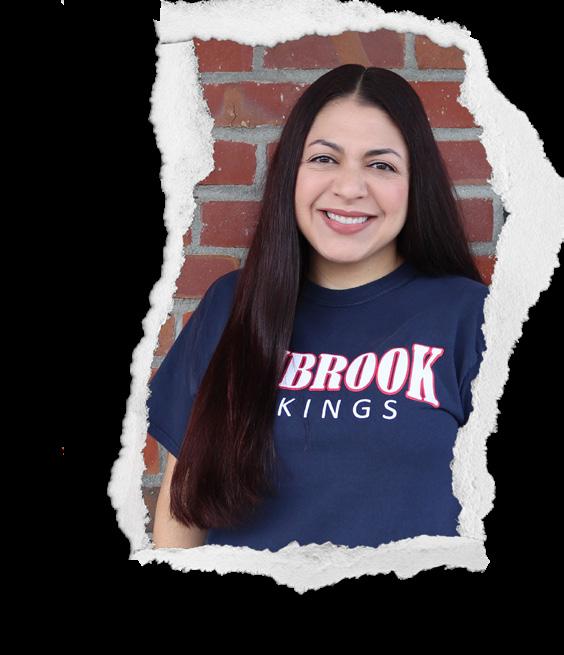

After decades of advocating for hairstyles like afros, braids, natural hair and locs, as well as the artistry involved in them, many now embrace their curly or wavy hair textures. A multitude of hair products and styling techniques meant for all hair types such as hair mousse, curl cream and diffusers have allowed many to embrace the beauty of their natural hair.
“In high school, I always wanted to look like everyone else,” Lee said. “Now, my wavy hair






BY ANGELINA FENG AND ALYSSA WANG
In a transitional kindergarten classroom at Dilworth Elementary School, a poster containing neopronouns has garnered controversy, as some parents believe that it is inappropriate for children to learn about such topics at a young age. ese discussions initiated the foundation of the organization, Curriculum Integrity: a group of concerned parents and guardians from the Cupertino Union School District.
Since Aug. 22, members of the organization have attended CUSD board meetings to petition for the removal of supplemental materials regarding gender uidity and neopronouns in elementary classrooms. ey were met by other CUSD teachers and parents who believe it is important to introduce such topics early on, protesting against backlash the teacher received. Curriculum Integrity responded with a petition, asking the board to take action and set stricter guidelines for what is taught in the classroom.
e controversy when parents noticed a “We are Free to Be” poster in room 22, including gendered pronouns such as “he,” “she” and “them” and various neopronouns including “ze” and “tree,” the latter of which they believed to be un t for elementary students. In September, they began outreach, informing other parents about the poster, evolving into the organization Curriculum Integrity. Group members claimed that there was an abundant amount of gender-inclusive books and a lack of literature that focused on other aspects of identity — ethnicity, language and culture. Parents said that they did not know these supplemental materials existed within the curriculum, and unlike sexual health education in h and seventh grade, they have no option to opt-out of those topics.
policies that outline how the school community should contribute to the well-being and development of the student. CUSD adheres to these guidelines for statemandated sexual health and HIV education. Parents have the opportunity to attend a webinar to learn about the curriculum and reserve the option to remove their student from selected lessons, the unit or the whole program. Curriculum Integrity members expressed that they should be given the same options for discussions about gender uidity.
Parents and teachers came to several CUSD board meetings to share their opinions on how the district should handle the matter. Some parents argued against the addition of gender identity in the TK curriculum. Other CUSD educators and those in support of the teacher’s lessons defended the teacher’s ability to teach their students about a part of their individuality — a topic these speakers believed relevant to the students’ future understanding of gender identity and growth.

“When we talk about curriculum, no matter the age, the key piece is that it’s developmentally appropriate,” said Ashley Kipple, De Anza College instructor of child development and education. “When we are talking about a class of 4- and 5-year old students, the idea of gender is appropriate to have dialogues about as gender identity development starts around the age of 3 years old. at’s going to look very di erent than it should in a rst grade, h grade, high school or college classroom.”
California Education Code 51101 states that parents and guardians have the right to examine the class’s curriculum materials and collaborate with the school to adopt
Cupertino Education Association, CUSD’s teacher union, withheld the name of the teacher from room 22 due to claims of harassment. e teacher later spoke at the Sept. 12 board meeting, explaining how they never felt like they fully belonged growing up queer at Christa McAuli e Elementary School in CUSD. ey voiced their belief that many current CUSD students feel the same and will continue to unless the board takes immediate action to support LGBTQ+ students and sta by implementing more LGBTQ+ inclusive policies.
“We know our schools and communities are safer for LGBTQ+ teachers and families when inclusive practices are explicitly named,” said CEA President Kate Lee in a statement to NBC Bay Area. “CEA continues to urge CUSD to a rm their commitment to the safety of our LGBTQ+ community.”
Curriculum Integrity created a Google Form petition requesting the CUSD Board immediately establish policies requiring educators to follow strict, grade-level curriculum standards and remove all curricula not within those set speci cations. is petition amassed over 450 signatures between Sept. 26 and Oct. 1, according to the Curriculum Integrity website.

We love our teachers, but teachers are not experts on designing curriculum. The experts design the curriculum to be age-appropriate, so it is critical to follow the curriculum.
Representative from Curriculum Integrity
“e experts design the curriculum to be ageappropriate, so it is critical to follow the curriculum,” a representative for Curriculum Integrity said in an email interview. “Meanwhile, we understand the importance of the use of supplemental materials. Our petition re ects what we think is the best framework for the district to handle matters that concern more complex topics in early elementary education.”
Members of Curriculum Integrity requested that CUSD allow parents who believe that gender identity topics are too complex to be able to withdraw their children from such curriculum. ey also wanted to establish an appeal system in which parents can submit objections to the educator or school administration if controversial topics are brought up in the classroom. eir petition also emphasized implementation of FUHSD Board Policy 6144 which states that instruction on controversial issues should be relevant to the adopted curriculum “suitable to the age and maturity of the

CA Education Code 51101 - Parents and guardians have the right to examine class materials, be informed by the school, and participate in the education of their children.
FUHSD Board Policy 6144 -
Instruction on controversial issues should be appropriate to match the maturity of students.
California Education Code 66040
- The school board should include educational materials that accurately portray the cultural and racial diversity of society.
California Education Code 60045 - Materials in the classroom should be grade appropriate.
CUSD Administrative Regulation 6144 - Outlines CUSD’s specifc implementation of BP 6144, which could be for or against gender identity.
students.” Educators are able to choose which topics are appropriate topics for discussion under this policy, yet the superintendent and administrators can prevent teachers from speaking out on issues the Board deems unsuitable. According to the policy, “teachers are expected to act on behalf of the district and follow the adopted curriculum.” Moreover, in class discussions about issues that may be controversial, they are restricted from advocating for their personal opinions. Advocates for Curriculum Integrity argue that because FUHSD has already incorporated BP 6144, CUSD should follow suit.
“If there was dialogue in a classroom because children were asking questions and trying to understand the world, then it’s developmentally appropriate to start unpacking some of those questions in a language that they can understand.
Ashley Kipple De Anza College instructor of child development and education
““Deciding if curriculum is developmentally appropriate takes into account the cultural context of the children and the community members,” Kipple said. ose who deem the implementation of BP 6144 unnecessary claim that this would create confusion among students and detract from discussion.
“It will create a chilling e ect on people who feel like they aren’t able to exercise their own professional judgment and share their own interests and identities, which is part of how teachers make interesting and meaningful connections with students,” a CUSD parent and alumna said. “Moreover, if we say that anything we are uncomfortable with is controversial and opt our children out of that kind of education, it essentially creates a back channel for prejudice.”
As discussions regarding the implementation of BP 6144 continue, Curriculum Integrity sent a news release to the Mercury News, NBC Bay Area and other local media sources, reiterating their wish for BP 6144 to be adopted, referencing a ruling by the ird Circuit Court of Appeals in a similar case in Pennsylvania. In October, a er a 2-year lawsuit, the court sided against Mt. Lebanon School District in Pittsburg, Pa., a er a rst-grade teacher read two novels about gender dysphoria and transgender transitioning to her students.


BY ISABELLA CHIU AND AMANDA JIN
As recent heat waves set the Bay Area ablaze, students found stepping outside nearly unbearable. Even in the middle of autumn, constant sweat and intense sunlight made many feel like it was still summer. Rising temperatures in early October have reached record-breaking numbers of 106 degrees Fahrenheit in San José, corresponding to global temperature trends.
In the Bay Area, late September and October have always been known for their heat, despite being considered fall months. This heat, often referred to as “second summer,” has become more common and extends for longer periods of time.
“Having a heat wave during Homecoming week was pretty brutal for the performers,” senior Arnav Singhal said. “It was hard to focus on work during that time.”
Despite this occurring regularly, this year’s second summer reached shocking numbers. According to the Applied Climate Information System, the latest heat wave on Oct. 2 hit 106 degrees Fahrenheit, shattering the previous record for high temperatures in October, set on Oct. 5, 1987 at 101 degrees Fahrenheit. In the past 10 years, the highest temperature during these months on average was 94 degrees Fahrenheit, only surpassing 100 degrees Fahrenheit once before. This year’s jump in heat has affected many, resulting in staff and coaches postponing student-athletes’ games and rescheduling practices to accommodate the extreme
heat. Lynbrook’s feld hockey team experienced this frsthand.
“Not having practices due to the high temperatures is important for player safety,” junior and girls varsity feld hockey player Mahi Shah said. “However, a long break from training also made it diffcult for us to maintain and improve our skills during that time.”
Consistent practices and training are important for athletes to reach their fullest potential; according to a study by Redline Athletics, athletes who train 2.5 times or more per week had a 66.48% increase in strength. However, due to district-wide regulations for sports practices that state that games and practices cannot be held if temperatures are above 86.2 degrees Fahrenheit using the calculations of WetBulb Globe Temperature, the heat wave left many to train at different times of day, independently or not at all.
Temperatures in the Bay Area correspond with the overall global trend in climate, with industrialization in society being a dominant factor in this trend. According to NASA, the Earth became 2.45 degrees Fahrenheit warmer in 2023 compared to the average temperature from 1850 to 1900.








The abundant amount of exhaust from natural resources used since the Industrial Revolution that occurred in the late 18th and early 19th century has contributed to an increasing amount of record-breaking temperatures each year in the 21st century. The byproducts produced led to the amplifcation of the greenhouse effect: solar radiation and heat being trapped in the Earth’s atmosphere, instead of being refected back into space, causing an excessive increase in heat. The largest source comes from transportation, which has reached 28% of the total emissions in the United States, according to the United States Environmental Protection Agency. Urbanization in many modern countries has led to the urban heat island effect in highly-developed cities such as San José. Buildings and other infrastructure are densely packed with little vegetation, especially apparent in East San José, according to the National Oceanic and Atmospheric Administration Climate Program Offce and Climate, Adaptation, Planning, Analytics Strategies Map. Compared to natural landscapes, these structures re-emit solar heat much more, causing the formation of small islands with warmer atmospheres compared to their surrounding areas.
“There is variability of temperature between one place to another place,” said Ismaila Diallo, assistant professor of the Department of Meteorology and Climate Science at San José State University. “Buildings have the largest effect in San José, which also means less green areas.”
In the Bay Area, there exists a highpressure system which has been a major factor in facilitating the heat wave. The system causes the air in the atmosphere to be compressed downward, heating it up. Additionally, this system leads to a highpressure seal, forming a heat dome and trapping the warm air in the region. This system also prevents the marine layer, an important regulator of temperature, from thinning out and being unable to penetrate inland.
area. Air descends to lower altitudes in high-pressure areas, resulting in the compression of air and the formation of a warmer air mass. Warmer air holds more moisture than colder air, resulting in lower levels of humidity.
“Sometimes we see heat waves with even less humidity,” Diallo said. “When you have high pressure, the moisture moves from high to low altitudes, so you will see less humidity in that area.”
These lower levels of humidity contribute to the dryness that many regions across California have experienced. Together with the heat waves, this results in an increased chance of wildfres in a state renowned for its fery blazes. A study published in the Journal of Geophysical Research Atmospheres, reveals 60% of wildfres happen during hot and dry days.
As temperatures rise, so does the demand for air conditioners, the use of which contributes to further environmental instability. Within the past two decades, air conditioner usage in homes around
Climate Collective Lead
sometimes it helps to put things in perspective: If you increase or decrease the temperature in classrooms by just one degree Fahrenheit, how many trees are you saving?”
Another prominent side effect of heat waves is heat-related illnesses with varying degrees of severity, ranging from mild complications of heat cramps and fatigue to severe heat stroke. As temperatures in the environment rise, it becomes harder for the human body to regulate a healthy body temperature.
“During the heat wave, people seemed more lethargic,” Shah said. “It was kind of hard to sit down and focus on the learning we needed to do.”
The recent heat waves, paired with California’s dry climate, are affecting many aspects of daily life, such as sports and wildfre safety. With California’s daily maximum average temperature being predicted to rise 4.4 to 5.8 degrees Fahrenheit by 2050, heat waves similar to those in October are projected to occur more frequently with increased severity in the near future.
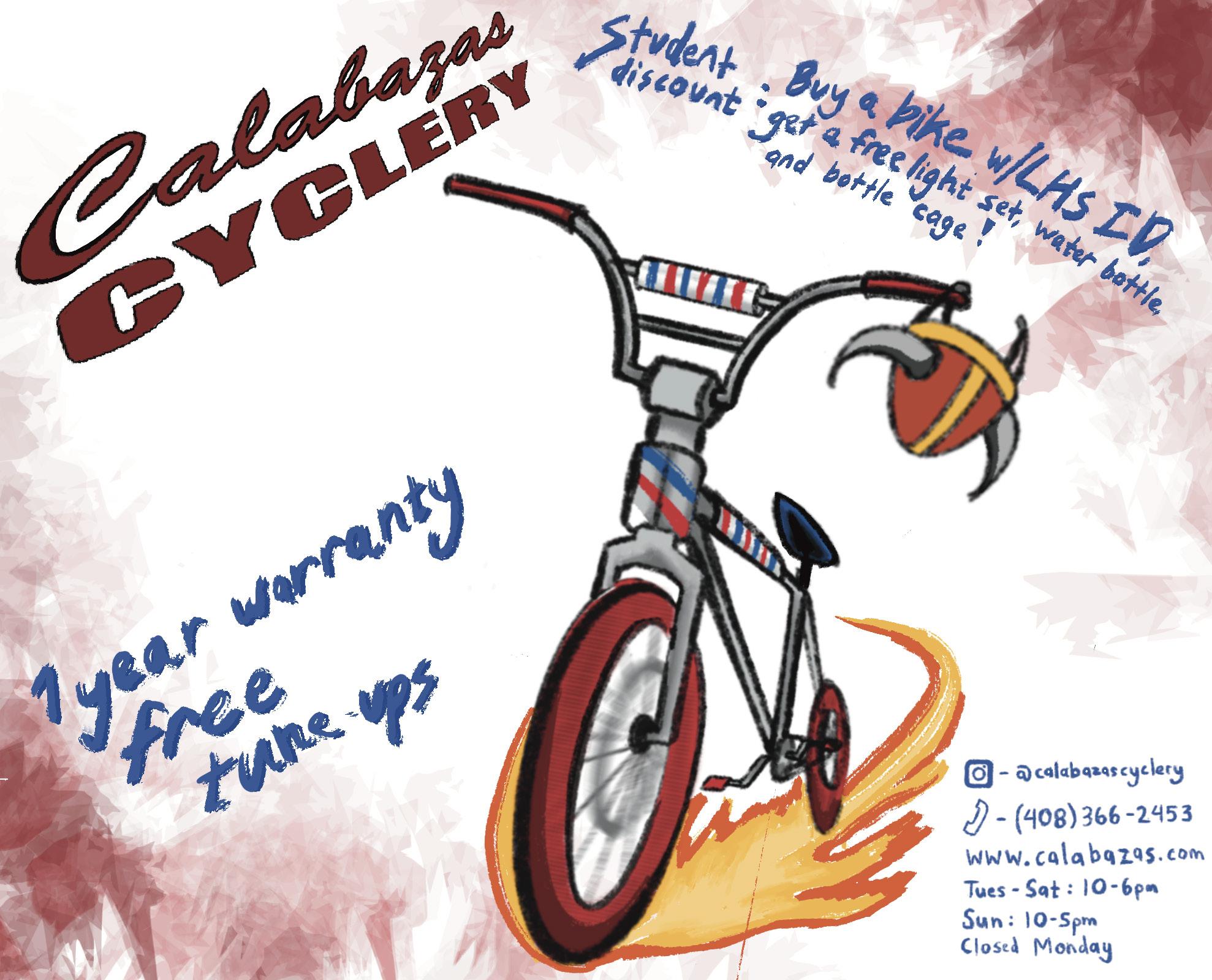
BY MEADOW SHEN
In recent years, school sports have become more active in their communities by hosting fundraisers supporting different charities. These initiatives positively impact communities as they promote and lend monetary support to charity organizations that lend aid to causes that beneft society such as support for those who have breast cancer. Given the benefts of fundraising, sports teams should consider hosting and integrating more charity events into their schedules.
Fundraisers beneft athletes beyond the technical aspect, allowing them to strengthen their teamwork and leadership skills. The impacts of sports play an important role in building a sense of community among students as well as lowering barriers between students and the causes of charities.
“It’s good to lend support to important causes and raising money through sports is a great way to accomplish that,” senior and varsity basketball player Alice Wu said.
In hosting fundraisers and charity events, sports teams may draw on support from volunteers and staff for help manning the tables. Through these interactions, teams can foster a stronger connection with local residents and increase their involvement in the community. Sports-based charity events also spread awareness as they inform
the school community of important information about these causes in the process.
Besides improving community engagement, fundraisers help promote teamwork among players who need to work together to host charity events. Whether it is brainstorming ways to support the cause, planning the logistics or working together to advertise the event, these fundraisers unite teammates.
On Oct. 11, the Lynbrook girls varsity volleyball team dedicated their game to fundraising for the American Cancer Society. The American Cancer Society is an organization devoted toward combating cancer, mainly through advocacy and research. In consideration of October being Breast Cancer Awareness Month, the girls volleyball team decided to support ACS’s cause, raising money to donate to their research. The night of, students and parents who came out to contribute to the fundraiser had the option to donate one dollar to be entered into a raffe for gift baskets. The raffe raised $250 in support of the American Cancer Society.
“The fundraiser brought attention to not only our sport but also the American Cancer Society,” senior and varsity volleyball captain Tanya Wang said. “The athletic senate talked about the organization between games which helped raise awareness about the issue.”
Besides girls volleyball, Lynbrook’s


varsity football team has also organized games that support certain causes. On Oct. 17, the team dedicated the evening game toward promoting breast cancer awareness by having all attendees dress in pink. In doing so, the game aimed to improve students’ knowledge about breast cancer and encourage fundraising in support of life-saving research for this cause.
“The breast cancer awareness game helped with team unity as it gave us a stronger purpose to play for,” junior and varsity football captain Naman Maheshwari said.
Some may argue that these fundraisers are time-consuming, entail meticulous planning of logistics and advertisement and interfere with players’
intensive practice and game schedules. Nevertheless, these fundraisers incentivize students to become more involved in supporting charities and different causes, while working as a team to host such an event promotes team unity.
Moreover, these charity events are invaluable for communities. By bringing more awareness to important organizations, these fundraisers help foster empathy and solidarity among community members for charitable causes. Connecting a diverse group of students, parents and adults, these fundraisers strengthen community ties and break down barriers between people.
“We weren’t just playing for ourselves, but for a bigger cause,” Maheshwari said.
BY JENNY SUH
Seniors Aaditya Jain and Annie Peng, the leaders of Lynbrook’s Athletic Senate, are behind the recently added award, Athlete of the Month. This newly established group focuses on hosting spirited student sections and recognizing sports teams and individual athletes by presenting awards for notable sportsmanship.
The Athletic Senate, frst proposed by Jennifer Griffn, the athletic director, was an idea that stemmed from Lynbrook’s highly academic environment where she felt that many athletes were often overlooked. While her original plans began in 2018, progress was delayed until 2023 due to COVID-19. They focus on shifting the negative perception of athletics at Lynbrook by making sports games more exciting with themed events and student sections. This has increased the publicity of these games, drawing more students to cheer on their peers and participate in school sports.
“We want to highlight our athletic accomplishments and teams,” Griffn said. “One of our goals is to bring more students out to games.”
Griffn introduced this idea to Jain, the ASB Secretary at the time. He was able to provide help in overseeing interviews, bringing the Athletic Senate to
lack of members. The following school year, Griffn presented a new application system during the athlete interest meeting, looking for potential candidates to bring visibility to a large group of athletes. Through a rigorous written application and interview process, Peng and Jain were chosen as co-presidents to lead the group.
“When Mrs. Griffn had this idea of the Athletic Senate, I thought it was a great opportunity that I could contribute to,” Peng said. “I’m also an athlete, and I wanted athletes to be more recognized and overall have better publicity.”

A new addition to the senate is the Athlete of the Month award, recognizing student athletes who demonstrated outstanding sportsmanship and leadership among their teammates. Each month, the Athletic Senate sends a form to coaches, allowing them to nominate one student from their team. After a discussion within the senate, one female and one male winner is chosen. Currently, the Athlete of the Month recipient is featured on the Lynbrook Athletics Instagram page, but the Athletic Senate is working toward incorporating additional incentives for the award recipients, including recognition through morning announcements or the weekly newsletters.
“The purpose of the senate is to recognize, respect and appreciate our student athletes on campus,” Jain said. “We also hope to make students realize that athletics are fun and encourage them to

Managers. The senate is divided into two primary departments: public relations and events. The public relations team is responsible for creating promotions on Instagram for each game and featuring Athlete of the Month award winners. Meanwhile, the events team focuses on organizing student sections and themes at sports games. Together, senate members meet bi-weekly to discuss upcoming events and select the Athlete of the Month award recipients.
Besides awards, the Athletic Senate focuses on bringing sports to a larger audience of students. With Lynbrook’s mascot, Victor the Viking, and themes like “Pink-out,” the senate is creating a more engaging and exciting environment for the audience at games. The Athletic Senate also helps organize fundraisers for charities in collaboration with sports teams, like their recent raffe event with the American Cancer Society, where they raised more than $250.
We hope to incentivize people to come to these events to participate, be a part of the crowd and cheer on our teams. All our events excite people to come, whether it’s some form of competition or fundraiser.
Aaditya Jain Co-president
Looking ahead, the Athletic Senate aims to expand the amount of events they plan. They also plan to host an end-of-year banquet to celebrate all Athlete of the Month winners and introduce additional awards, such as Athlete of the Year and Coach of the Year. They continue to work closely with Griffn to bring more engaging, interactive activities during halftime, such as a half-court shooting contest during basketball games.
“I look forward to seeing all that we can do,” Griffn said. “I have a great group of students, many of whom are athletes, that are working hard to keep our athletic teams in the spotlight.”
BY ASHLEY HUANG
For junior Selen Turkoz, equestrian sports began as a childhood fascination. After watching “Free Rein,” a Netfix show about horseback riding, she found herself captivated by the connection between rider and horse. However, it took a year of convincing her dad before she fnally got a chance to ride.
“I was jumping between sports, but nothing felt right until I tried horseback riding,” Turkoz said. “The connection with an animal that doesn’t speak your language but still communicates with you feels magical.”
Turkoz frst started riding at 11 years old, learning the basics of Western riding — a style that features a more relaxed seat and the use of a horned saddle. She eventually decided to pursue Englishstyle riding, which emphasizes precision and balance in techniques such as show jumping. While horseback riding initially began as a hobby, her natural talent and love for the sport pushed her to seek out more structured and competitive opportunities. Her mom, recognizing this, encouraged her to join a competitive team, setting Turkoz on a path toward a serious commitment to equestrianism. After a year of training, Turkoz made Stanford University’s equestrian team as a freshman.
“Ever since she was a child, Selen would have phases of interests,” junior Saliha Dogan said. “She becomes very dedicated to the interest and makes it the focus of her life, practically breathing it. Equestrian is one of them.”
Although Turkoz has an immense passion for the sport, the fnancial barriers to improving in equestrian sports have been a challenge. Competing at a higher level requires not only skill but also access to resources such as additional lessons and specialized training — all of which come with steep costs.
Despite the high prices, Turkoz remains dedicated and motivated. She has developed a strong sense of discipline, organizing her time carefully to ensure she can give her best in both her academics
and riding.
“I block off my Tuesdays completely for practice,” Turkoz said. “I know I’ll be tired after, so I plan everything ahead. Monday is my grind day to get all my work done.”
Focused on improvement, Turkoz trains under Stanford coaches Tina Davey and Katie Steiner, honing her skills, particularly in English riding and jumping.
of stress to this competition.
However, Turkoz stayed concentrated by going through her warmups and refecting on past mistakes. Recognizing her feelings, she texted her friend group asking for prayers and support. Although her friends, mom and coaches continued to encourage her, she was still doubtful. Turkoz was alone in the ring and only had herself.

Specifcally, Steiner has become a trusted mentor, offering both practical advice and emotional support. From fxing her posture in the ring to calming her nerves before competitions, Steiner’s presence has had a great infuence on Turkoz and her journey.
Over the years, Turkoz has developed a special bond with many of the horses she rides, but one stands out above the rest — Sheldon, a retired racehorse with a mischievous personality. Turkoz credits him with helping her fne-tune her skills.
“Sheldon forces you into perfection,” Turkoz said. “If you don’t ask him the right way, he won’t do it. He’s also a character off the track, always trying to unzip my backpack.”
One of Turkoz’s proudest moments came during a competition in 2023 that determined her qualifcation for regionals. She had previously struggled with the horse, Molly, assigned to her that day. Molly had been unresponsive to her cues and acted unpredictably in a previous competition, which added an extra layer
“I couldn’t rely on anyone else, it was my time to put everything I’ve worked on for years to the test,” Turkoz said.
Through her prior experience with Molly, Turkoz used her knowledge to keep the horse calm, follow the horse’s movement and adapt to Molly instead of relying on the horse to work with her. She made sure to stay patient between each transition, striving for high quality.
“I pushed away doubts, focused on the challenges and powered through them,” Turkoz said. “I learned to trust my judgment during this competition.”
In the end, her work paid off, and she secured second place — just enough to qualify for regionals.
“When they called me for second place, I started crying and went to hug my mom,” Turkoz said. “It was one of the most rewarding moments of my life.”
While she has placed frst in previous competitions, this second-place win felt more signifcant due to the stakes. This victory not only marked her qualifcation
for regionals but also her growth as a rider.
Looking ahead, Turkoz plans to continue riding in college on an Intercollegiate Horse Shows Association team. One of her long-term goals is to buy and train her own horse, a dream that she hopes to fulfll after gaining more experience. For now, she remains focused on her current competitions and continues to build on previously developed skills.
Equestrian has shaped Turkoz’s character in profound ways. Beyond the technical skills in riding, the sport has taught her the importance of building deep connections with animals. Her appreciation for nature has grown through her time spent with horses, and she has learned to approach challenges with a positive mindset.
“You build bonds with horses, and those connections teach you patience and resilience,” Turkoz said.
Refecting on her years pursuing equestrian, Turkoz thanks her parents for playing a huge part in her journey.
“My mom has been my biggest supporter,” Turkoz said. “She’s the one who pushed me to explore competitive riding and always ensures I’m ready for competitions. She calms me down when I’m stressed and is there with me every step of the way.”
Turkoz’s dad has also played a major role in helping her achieve success. She is grateful for the emotional and fnancial support he provides, which keeps her motivated, allowing her to strive for a life that she otherwise couldn’t have pursued.
Looking back on what she has already accomplished, Turkoz encourages aspiring riders to focus on the relationships they build with their horses.
“Your connection with the horse is everything,” Turkoz said. “It’s not just about riding well — it’s about understanding and trusting the animal beneath you. Don’t get discouraged by setbacks. Every rider faces challenges, but those are what help you grow.”
BY ERIN FITZPATRICK AND OLIVIA TU
From vigorous sprints on the track to powerful strokes in the water, Lynbrook athletes push themselves to excel in their respective sports. To support their endeavors, trainer Scott Leveau works behind the scenes during games to ensure athletes can properly recover from injuries. However, he isn’t alone in his work: juniors Ayah Abood and Ilan Garcia work as interns under Leveau, assisting him intending to athlete health and gaining insight into athletic training.
Athletic training aims to improve an athlete’s physical condition and function. It encompasses the prevention of injuries, the treatment and rehabilitation of an athlete and methods to deal with chronic and medical injuries while playing sports.
For Abood and Garcia, interning in athletic training is a way to gain hands-on experience and a deeper understanding of the profession; they can also apply their knowledge from studies to real scenarios. Learning how to respond to the various injuries of each sport lets them aid a patient’s recovery process properly.
“I’m able to apply the skills learned from athletic training to real life,” Abood said. “I can tape my dad’s ankles or help wrap cooking burns.”
The opportunity to intern with Leveau is limited to a select group of students; interns have often established connections with him and have an ardent interest in sports medicine. Both Garcia and Abood were spurred
by the prospect of receiving frsthand experience in the health-related feld and creating a tangible impact.
“I’ve always loved watching sports and helping people,” Abood said. “Interning allows me to do something meaningful for my community.”
During the matches, after setting up their medical table to prepare for potential injuries, Garcia and Abood keenly monitor for accidents and constantly check in on athletes’ well-being. In the case of an injury, they assist Leveau by writing reports, fetching equipment and taking vitals.
To further their knowledge, the interns also learn outside of games. After school, Leveau frequently lectures on anatomy, physiology and techniques to deal with sports injuries such as tending to a wound.
The frst home football game of the season was a notable opportunity to implement and practice the materials learned. Working closely alongside Leveau, they managed busy situations while applying their handson skills under pressure. The experience was a real-world application of everything they had observed and learned from Levau.
“I was extremely nervous because I had never had any prior experience,” Abood said. “I learned to overcome the anxiety and actively participate. As I became more familiar with the process, it wasn’t as nerve-wracking.”
Throughout this internship, the students have also learned to adapt to struggles and learn from mistakes. Having an open mind and being coachable is one of the
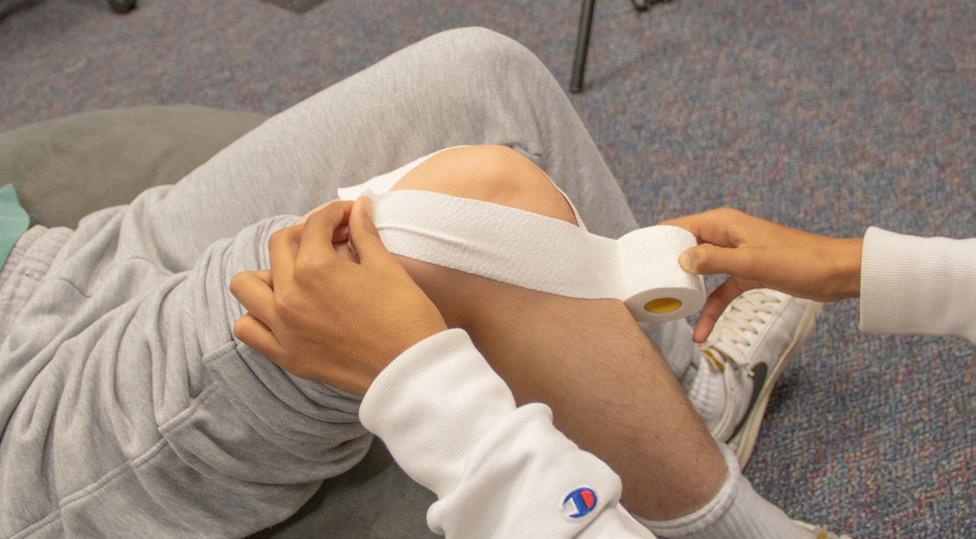
most important aspects of this internship.
“You need to know how to learn from your mistakes,” Garcia said. “This program has greatly improved my ability to learn from my past actions.”
From the internship, Abood and Garcia can apply the practical skills taught to daily life and for the future. Furthermore, the internship has allowed them to forge connections with diverse peers and enhance their interpersonal skills.
“It’s one of the biggest opportunities I’ve been given,” Garcia said. “We get to connect with injured athletes by providing peer-to-peer emotional support, which is different from that of a teacher or coach to a student. There’s a rewarding feeling from being able to help my peers.”

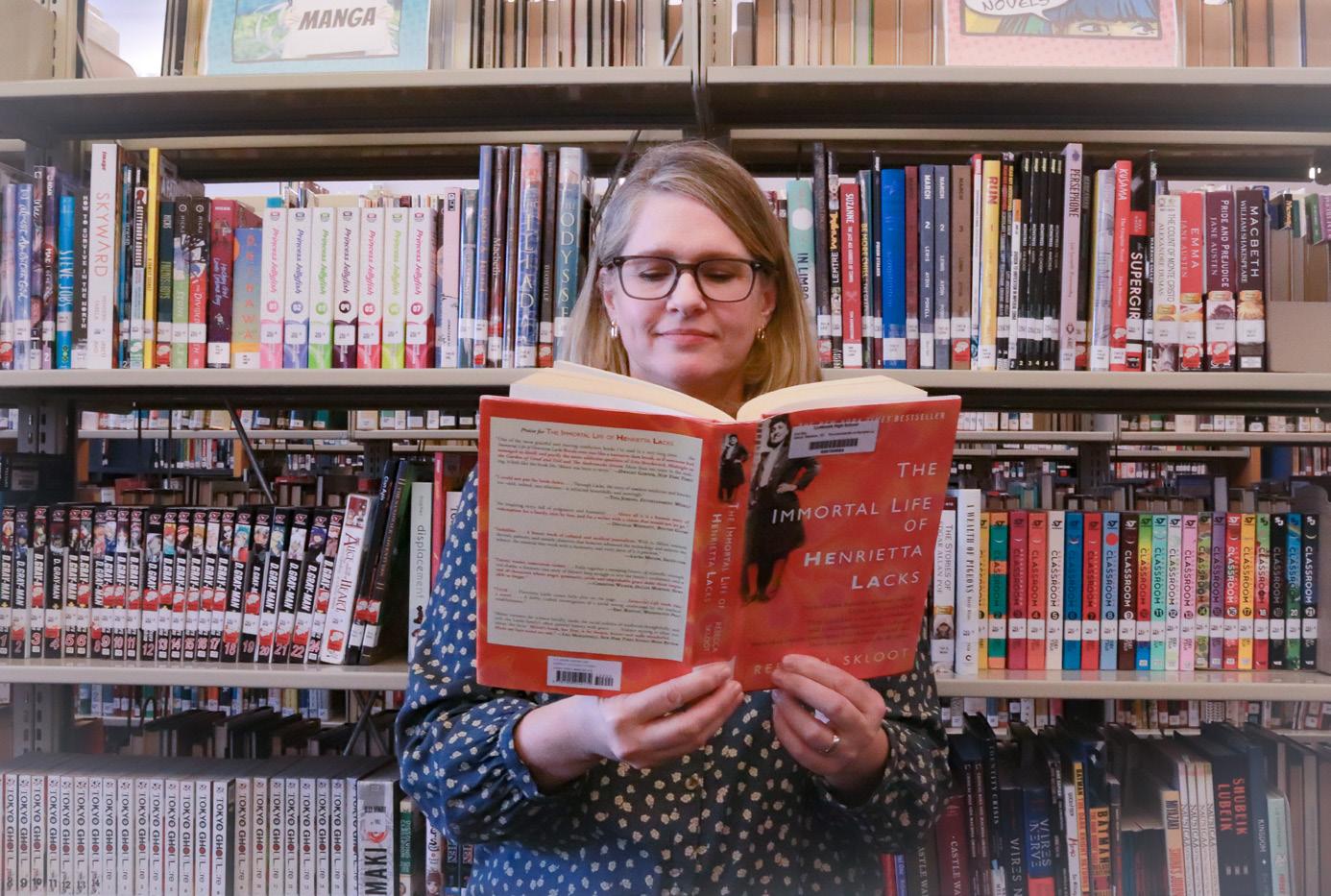


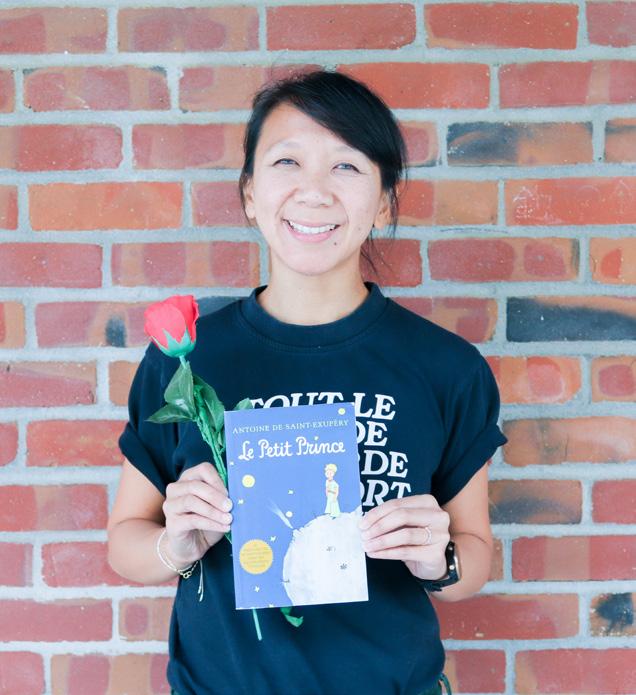


BY ALEX COTTEREL AND CRYSTAL ZHU
Works of literature fnd a home in the hearts of many Lynbrook staff; from nonfction to romantic classics, the emotions and harrowing stories of humanity bring joy and introspection to the staff drawn to these tales.
English teacher Jessica Dunlap and science teacher Thanh Nguyen have a fondness for John Steinbeck’s “East of Eden.” The intricate epic tells the story of two families in Salinas Valley, serving as an allegory to the biblical story of Cain and Eden. One main character, Cal Trask,lives under the shadow of his brother, wishing for his father’s love.
Dunlap frequently re-reads the book, exploring the story’s approach to themes of love, sin and redemption in the 1950s. Dunlap admires the unique friendship between Cal and Lee, a Chinese-American servant.
“We all need somebody like Lee in our lives to give us perspective and act as a mediator or liaison to help us get the forgiveness we need,” Dunlap said.
Library Media Specialist Susan Lucas has an affnity for non-fction stories, particularly, “The Immortal Life of Henrietta Lacks” by Rebecca Skloot. The book details the tragic story of a woman, whose cancer cells were harvested by researchers in 1951, and prompts refections about integrity and morality in science, journalism and the legal system.

“The story contains ethical questions that I will think about going forward,” Lucas said. “This book shows how science is going to have the answer.”
“Pride and Prejudice” by Jane Austen is a novel that stands out to art teacher Judy Schulze. The book’s ridiculous humor and main character Elizabeth Bennet’s strong disposition and other eccentric personalities inspire laughter and engross the reader.
“I found myself laughing out loud and re-reading parts saying, ‘Did they really just say that?’” Schulze said. “It sweeps you away into another world.”
Choir teacher Crystal Isola draws inspiration from the memoir “Lab Girl” by Hope Jahren. The memoir uses Jahren’s plant biology research as a metaphor to detail her own struggles as a woman in scientifc research, a male-dominated feld.
“She also talked about having mental health struggles,” Isola said. “Even though she is so accomplished and so brilliant, life is still hard, and that’s a universal thing.”
Antoine de Saint-Exupéry’s “Le Petit Prince” has been a signifcant part of French teacher Elizabeth Louie’s life ever since she read the book on her frst trip to France. The novel’s stories and lessons have stuck with her through breakups and hard times, as she shares its lessons today with her students.
“As an adult, you forget the things that matter,” Louie said. “You need to know the importance of slowing down and taking the time to build relationships.”